- New! – Global Tour Search
- Full-Service Worldwide Operator List
- Regional & Specialized Operator List
- Submit a Review
- What Tour Companies Won’t Tell You
- Links to Other Bike Tour Sites
- List With Us

Trek Travel Bike Tours
September 30, 2016 By gbd-admin 23 comments
A relative newcomer to the industry (they started business in 2001), Trek Travel does everything with an utmost level of expertise. In many ways it is as if they have analyzed the best aspects of the top companies, and incorporated these into their tours. The guides are top notch, the two levels of pricing accommodate a variety of budgets, and the large selection of tours cover a wide range of rider levels.
As they are the only operator owned by a bike company, you can always be assured that the bikes are top notch and in perfect condition. Companions – Hey, even if he says "It's Not About the Bike", this is the company that makes Lance's ride, so bikes and gear are front and center here. In other word, don't expect to see lots of folks in the SAG van. This is a pretty fit crowd. However, they do provide a large range of ride types, some as short as 30 miles a day (and some that include such challenges as Mt. Ventoux), so the large variety of rides, as well as price levels, lead to a wide variety of clients.
- Operator Type : Full-Service Operator
- Website : http://www.trektravel.com/promotion/biketourreviews/
- Price Tier : $$$
- Avg Price Per Day : $465-595
- Services : Bike Provided, SAG Van, Tour Guide
- Country : Austria, Chile, Costa Rica, Croatia, Czech Republic, Ecuador, France, Ireland, Italy, Norway, Peru, Portugal, Scotland, Spain, United States
Leave A Review Cancel reply
Name and Location *
Save my name, email, and website in this browser for the next time I comment.
CAPTCHA Code *
I would not recommend doing any business with this company. Their bikes are totally worn out. We trusted a friend’s recommendation and it turned out that was a bad decision. They are selling used bikes at thousands dollars, If I am paying over 2K for a used bike, I expect it is in a fair condition. The truth is that their checklist was not accurate and dishonest. For example, the crank teeth are extremely worn and the di2 charging and mounting is missing. This is just wrong. If they are selling used bike like dumping garbage but still make you to pay thousands of dollars, this is absolutely not the company you should trust. I paid for my mistake and I am hoping that my stupidity can be a warning for you. A company without integrity, think twice!
First time Trek Travel tour. Did the Portugal trip out of Vila Viscosa, mid-November. Everything was great. Bike provided was exceptional, guides were friendly & personable as well as knowledgeable about the area, top notch accommodations, great food @ hotel and at restaurants. Plenty of snacks and support along the bike routes. Word to the wise: you should be in good shape. Our trip was labeled “recreational.” Participants were fit and didn’t dilly-dally. That said, you can opt for an electric bike, if need be. Side tours were wonderful too (vineyard, palace & museum on rain day, guided tour of local village). Terrific followup from Corporate HQ on any questions or concerns. Would recommend and would do a TrekTour again.
My parents booked a Trek trip in Italy this spring. We’re very disappointed that with the coronavirus escalating in Italy, we cannot attend. When we called Trek to cancel, we were surprised to learn that there were no plans to cancel the trip and we couldn’t cancel without losing a significant amount of money. My parents are rightfully concerned with Trek’s disregard for our health and safety. The situation continues to evolve, but as of today, Italy is under a country wide quarantine, travel is restricted by both Italy and the United States and the spread or the virus and death toll show no signs of slowing. Trek offered an option where we could rebook in another location, but we cannot entrust our wellbeing in any location to a company who is encouraging us to risk our health and safety, as well as the health and safety of our communities, by traveling to Italy. Luckily, the airlines offered a refund on our travel, prioritizing human life over profit – we encourage Trek to do the same.
We paid for a self-guided tour this May in the Provence region of France. While we loved the trip, Trek Travel did little to provide any support. They charged us $7000, and basically they gave us some bikes and routes and let us go. For the money we were charged we were expecting a lot more from the company. Nice bikes, but talking to other people on other tours, including the guided Trek tours, we feel we were taken advantage of. We do not recommend Trek Travel.
Did the Tour de France Team Access trip, Trek’s premiere offering. Much was promised and the price was among the highest in the industry. Accommodations, food, Radio Shack team access were great. Unfortunately, the trip was understaffed; 3 guides, 1 van for 24 people. There was little ‘on the road’ support. Two guides were rookies to the trip and the company. Tour viewing was far less than promised.
Excellent support, fun guides, and unbelievable viewing locations for the Tour de France.
I took the Trek Travel economy tour of Bryce and Zion national parks in fall 2005. The bikes were exceptional (as you would expect of Trek); the guides friendly and hard-working; and the other riders fairly strong and very social, ranging from 25 to 55, average age about 40. The accommodations were excellent, some top notch restaurants included with tour; and the routes we rode were challenging with amazing scenery.
What you would expect….great rides and route finding, perfect bikes, fantastic accomodation and knowledgeable and personable guides who we now call our friends. Plus TREK TRAVEL organized local and unique cultural experiences for our group which were unexpected and fantastic (eg. local vineyards, a catalonian historian, etc, etc.)
Tour de France viewing at its best. The food in France not very good, as always. Somehow the Pizzas were great. Great scenery The Guides are A+.
This is the A+ way to go! Trek travel is quality with real human excellence. The don’t aim to please, they simply do. The bikes are excellent, but that wouldn’t matter if they weren’t so truly superior in choosing and retaining the best guides in the world! This is a bike tour with a never ending grin! Thanks Trek Travel!
I would like to say the trip we had this fall with Trek was outstanding, the accomodation,food, attention to detail, and most importantly the daily routes they had designed for us were all incredible. The guides made the extra effort to ensure we all had a great time, and also ensured that everyone was looked after as far as personal requests, special energy drinks,foods,cultural side trips, and route changes to suite exploring and shopping needs. I have had several trips cycling in different regions of Europe, private trips, self guided, and group trips, I have always had the best experience with Trek. We have already booked our next trip with them for this summer. We are looking forward to another “trip of a liftime” with the great folks at Trek.
My wife and I have been on 3 Trek Travel trips to Europe. We highly recommend the trips. The guides worked very hard and provided the best advice, assistance and friendship throughout the trips. Bikes were top quality. Rider level was above average but not competitive. Accommodations and food were very good. Can’t wait to go again. Provence was extra special.
I have been going to Europe for 35 years. I’ve acquired a “I’ve seen it all” mentality, a shame really, but I’ve been to Italy 30 times and thought I had “been there done that.” I never expected the amazing trip and new experiences I had with Trek Travel to Puglia. It was truly one of my greatest experiences in Italy.
We are not “tour” people, and usually enjoy making our own way with a map and a good guide book. This trip was one of the most relaxing vacations I have ever had – great exercise, great food, great accommodations, great company and we were completely pampered.
This trip was better than anticipated — and I had high expectations based on previous participants’ reviews! I am now convinced that this is THE way to see a new country and experience its culture; by the sights, sounds, and smells only obtainable by cycling through its countryside. The support of the Trek Travel guides made it exceptionally easy and enjoyable. A perfect way to spend our 15-year wedding anniversary!
Trek is the best travel group especially for the Tour de France where access and logistics are so critical to a wonderful experience.
This was yet another outstanding Trek Travel adventure. From the equipment to the routes and the overall expertise of the guides, it is hard to imagine that any tour group could do it better. This was our third trip with Trek Travel and we look forward to many, many more.
One of the wonderful features about Trek is that high-quality, well-equipped bikes fit to the rider’s specifications are provided, saving the traveler time, expense and worry.
Everything planned exceptionally – but adjustable as necessary.
This was our first Trek Travel trip. We knew we would enjoy it since we love to ride bikes. We never expected to walk away feeling that we just experienced the best vacation we have ever had. This from two people who have traveled every Continent but Australia and have had very memorable experiences. On the flight home we were already planning our trip for next year. We are hooked!
One of the things I really liked was that I didn’t have to transport my own bike to CA, and that the Domane provided was a very good, high-end road bike. I also loved the chance to ride the Di2 (I was sold on it in the first three miles) and it was a let-down to return home to a mechanical-shifting bike!
Most cycling tours also offer snacks and drinks all the time. But beer, sunscreens, water bottles filled up without asking, water bottles moved under shades, luggage carried to our rooms? It was five stars service all the way.
From the moment we arrived, we were treated like movie stars – and you just can’t buy that anywhere else!
Your Go-To Review Resource
Quick links.
Your Name (required)
Your Email (required)
Your Message

Mon-Fri 10am - 8pm | Sat-Sun 10am - 6pm
- Account Account
- Store Store
- Subtotal : $ 0.00 Checkout Cart
Trek Travel
Cycling vacations of a lifetime, the trek travel difference.
You’ll know our difference the minute you say our name. We’re born from Trek bikes, and that means everything that makes Trek great is in our genes, too. Like the passion to be the best. To make adventure accessible. And to do things right, in the right way. We’re a team of globetrotters, world-travelers and dreamers who know how to inspire the memories you’ll have for the rest of your life.
From fine dining, wine tastings, world-class hotels, meticulously planned rides on beautiful roads, to a perfectly tuned bike, and constant support from the friendliest people you’ve ever met. If this doesn’t sound like your definition of adventure, maybe it’s time to reconsider.

BUILT FOR EVERY RIDER
Our guests all share one thing in common: they believe that seeing the world by bike is better. We make sure to have the perfect trip for any riding level whether you ride for the breeze, the fitness, the transportation or the suffering of it all. With over 50 destinations around the world, there’s truly a trip for every traveler.
THE BEST BIKES
Part of what makes a bike vacation great is the bike you’re riding. There’s no tour operator that gets it more than us. It’s why we provide, at no added cost, the kind of bikes that ride so exceptionally, guests want to buy them when the trip is done. Whether it’s the ace-ready Trek Domane with electronic shifting, or the exhilarating power of an electric-assist bike, you'll find the ride you want here..
ROCK STAR GUIDES
Certified mechanics, experts in riding and trained in delivering uncompromising service in ways you won’t believe. Our guides are here for whatever you need whenever you need it, whether it’s a shuttle up the hill or a wine recommendation.
THE WORLD CALLS
Welcome to Trek Travel. Here, we don’t just promise a cycling vacation. We promise to change the very definition of what a cycling vacation should be. Where will you go? What will you do? Start your incredible journey by finding the trip that’s right for you.
START PLANNING

Dedicated to all those who believe the world is best seen from the seat of a bicycle.
The World’s Best Gravel Bike Destinations According to Trek Travel
Share this:.
- Click to share on Facebook (Opens in new window)
- Click to email a link to a friend (Opens in new window)

Everyone seems to be on the hunt for epic gravel bike rides these days.
The explosion of off-road races and social gravel rides in the past several years, coupled with a wide new group of riders who found biking during the COVID-19 pandemic, added more to the popularity of a segment of cycling that had been firmly set on the periphery of the sport for a long time.
But now that trained eyes have been scouring the globe for this niche gravel bike terrain, it looks like no region, city, or community is without a route that gets riders off paved roads.
But with gravel riding, there is always a chance that the road less traveled has been less traveled for a reason. Sometimes gravel rides tend to dead end into unrideable nothingness or land people on or too near to private property for comfort.
Having a knowledgeable guide to help find the path can make all the difference for those seeking out a new gravel bike adventure, and Trek Travel has been working hard over the past couple of years to carve out a role as that guide.
Trek Travel Trips
Trek Travel has been building cycling vacations for more than 20 years. Historically, most of the brand’s global destinations have catered to road cycling and touring. Now, the brand hosts rides in nearly 40 destinations in nearly 20 countries.

Some of the more popular trips include a cross-country trip from Portland, Ore., to Portland, Maine, and a trip to France that places riders on some of the most iconic climbs of the Tour de France.
This year’s new lineup of gravel bike trips centers on terrain that is more rugged and chunky than the brand’s usual road-centered offerings.
Trek Travel’s global network of guides has narrowed down all the gravel they could get their hands on to a shortlist of six destinations that are among the best in the world.
Green Mountains, Vermont
The Green Mountains of Vermont slice through the picturesque towns of Stowe and Waterbury, offering a healthy mix of bike paths and unpaved roads that connect riders to multiple cities and a variety of cool attractions, including the Ben & Jerry’s Ice Cream Factory and the Trapp Family Lodge, of “The Sound of Music” fame.

The mountainous landscape offers challenging climbs and fast, fun descents, along with sweeping views of farmland and foliage.
Whether on gravel or pavement, Vermont offers a lot of elevation to contend with immediately outside of towns. However, it also features a fun causeway over water that requires a small ferry ride to fully cross, architecture sweeping views at every hilltop.
Bentonville, Arkansas: Gravel Bike Hub?
The fact that Bentonville is on a list of cycling trip destinations shouldn’t surprise anyone. The city has become a destination for cyclists in the past several years. However, many Bentonville visitors come to the city for its extensive network of mountain bike trails.

As the town that hosts the Big Sugar Gravel bike race, it’s obvious that Bentonville is a slice of paradise for gravel riders , too.
Bentonville is situated in the Ozark Mountains but is also surrounded by farmland, so Trek Travel guides see it as a perfect spot that can accommodate riders of every skill level.
Amy Davison, one of Trek Travel’s trip designers, said Bentonville is a perfect destination for riders of all skill levels.
“One of the things that I’m most excited about is it’s not as hard as you think it’s gonna be. It’s in the Ozarks, but it’s also surrounded by farmland, and most of the gravel is rolling gravel roads in farmland, so it’s not quite as punchy or hilly as I expected,” Davison said. “I think that will be like the full ticket for absolutely any kind of gravel rider.”
Davison also said the culture of Bentonville provides another big draw.
“It’s just got a vibe that is all about cycling. As soon as you step foot in that town, you feel loved and welcomed and celebrated as a cyclist, and you don’t feel that everywhere you know, and it’s just all over town,” she said. “You see cyclists everywhere you see cycling infrastructure everywhere.”
Trek Travel sets riders up in a hotel just off the town square where riders can hop off the bike and easily explore the Wal-Mart Museum or the Crystal Bridges Art Museum after a long day of riding.
Shenandoah Valley, Virginia
The Shenandoah Valley sits in a bit of a pit between the Blue Ridge and Allegheny Mountains. Trek Travel uses the town of Harrisonburg as a launch pad where riders can jet off into rolling farmland and do some serious climbing.

Davison said Trek Travel connected with a local endurance gravel cyclist who helped design routes in the area. She said the routes in the valley typically involve more mixed terrain, including pavement, as it takes longer to get out into areas with gravel roads. Once there, riders wind rolling farmland, Mennonite communities, and towns that are hundreds of years old.
“It’s lots of farmlands, but also, we’re on the fringe of the mountains, so we get into the National Forest and throw a nice mountain stage at the end of that one to the high point of the state, which will be really cool and set it off a little bit from the other trips.”
Tuscany, Italy: Legendary European Gravel Bike Riding
Tuscany’s gravel is legendary . The Strada Bianche race is named after the white gravel roads in the Crete Senesi south of Siena on which pro riders battle every year. Usually, about a third of that race covers gravel roads.

The region also plays host to the L’Eroica vintage bike festival, on which participants ride on bikes from the ’80s rather than on the latest carbon speed machines of the day.
Davison said the roads of Tuscany also feature challenging hills that connect the northern Chianti region with the southern part of Tuscany.
While the gravel itself may not pose much of a technical challenge, the hills more than make up for it by bringing an added challenge to riders.
Tuscany’s roads are well known, but the culture of food and wine in the region is equally renowned, and riders have plenty of opportunities to sample both.
Girona, Spain: Technical Gravel Bike Terrain
Trek Travel has been running a gravel trip to Girona, Spain , for a while. It previously was the only such trip in the brand’s profile. It also has the distinction of being the ride with the highest degree of technical riding in the gravel bike lineup.

“They’ve got some single-track connectors in there and, in fact, some roads where the van can not follow to provide support,” Davison said. “So to us, we’re going to categorize that as a higher degree of difficulty because that will be different from a regular trip where the van can always follow you. Here they kind of have set points where the van meets everyone, but it definitely has some interesting connectors.”
Aside from single-track connectors, a good bit of the Girona gravel bike scene features sparsely traveled fire roads.
St. Moritz, Switzerland
St. Moritz is a resort town in the Swiss Alps at just under 6,000 feet of elevation. Having hosted the Winter Olympics twice, it’s obvious that there is plenty of extremely challenging terrain in the area to challenge cyclists when the snow melts.
Davison, however, said the idea behind the gravel trip to St. Mortiz was to offer a bit of an easier ride experience in which riders stick to the valleys rather than the frosted peaks that surround them.
She said the valleys around St. Moritz are littered with dirt roads that do not have major technical challenges, along with bike paths surrounded by mammoth peaks of the alps that provide a stunning backdrop all day.
Getting Into Gravel Biking
The new gravel bike offerings from Trek Travel give riders a new way to experience a destination by bike. It can be seriously challenging to find gravel roads and safely traverse them without experience or the ability to bail, especially overseas.

Trek Travel trips feature full support from a chase van, GPS devices, on-bike guides, and a fleet of highly spec’d Trek Checkpoints , so riders don’t have to worry about the hassle of traveling with or shipping their own bikes. Trek Travel guides also hand-pick hotels, restaurants, and off-bike activities to make sure riders get the most out of the region they visit.
“(We’ve seen) the trends of people wanting to buy gravel bikes and kind of get away from traffic in some cases, or just have that little more of a sense of adventure being out in the wilderness, but not necessarily mountain biking,” said Meagan Coates of Trek Travel. “So we decided to develop a bigger collection. I think it’s just kind of dictated by what people are liking to ride and the interest in providing more experiences for folks.”
The beauty of these rides is that they are just out there for anybody to ride, but having the help of a company like Trek Travel makes logistics simple.
Trek Travel offers trips to the destinations above at price points ranging from $1,799 to $3,299.

'Sakai City': An Inspiration for Japan's Emerging Gravel Scene
A new generation of Japanese cyclists discovers the joy of gravel riding in the culturally rich port of Sakai City. Read more…

Mark Wilson is a freelance journalist for GearJunkie and BikeRumor. Mark has been writing about cycling, climbing, outdoor events and gear for more than a year. Before that, he spent more than a decade as a journalist at major daily newspapers in Texas covering crime, public safety and local government. Mark spent every free moment during that time carving up singletrack and gravel, or climbing with friends and family in Texas, Colorado and Mexico. Based in Texas, Mark is always looking for new trails, crags and gear to help navigate the outdoors. As a new dad, he is particularly interested in learning how to share his love of the outdoors with his son.
Follow Us On
Subscribe Now
Get adventure news and gear reviews in your inbox!
Join Our GearJunkie Newsletter
Gear Top Stories Deals

How to Thru Hike the Appalachian Trail: A 101 Guide
Welcome to How to Thru-Hike the Appalachian Trail: A 101 Guide ! This resource is designed to help you understand everything you need to know about thru-hiking the Appalachian Trail. Here you will find information regarding the trail and the culture that surrounds it, gear talk, thru-hike preparation, hiking strategies, social etiquette, and much, much more. To skip to a specific subject of interest and for easier navigation utilize the quick links in the Table of Contents below.
Table of Contents
The southern mountains, the virginias, the mid-atlantic, new england, through the eyes of a hiker, trail magic, volunteer efforts, when to hike.
- Alternatives
AMC Hut System
- How Much to Carry
Water Treatment
- How Do I Find the Time and the Money?
- Registration
Sleep System
- Clothing (coming soon)
- Stoves (coming soon)
Hitchhiking
- Hostel Etiquette
Hike Your Own Hike (HYOH)
- Leave No Trace (LNT)
- Proper Pooping (coming soon)
- Safety Concerns for Women
- Beings Underprepared
- Hypothermia
- Dehydration
- Heat Exhaustion & Heat Stroke
- Should I Bring a Gun?
Further Reading
Trail terminology, what is the appalachian trail.

For a visual overview of the trail check out our Interactive Map of the A.T .
States: GA | NC | TN
Here there be mountains. The Southern Mountains are home to the A.T.’s southern terminus and is the first region of trail experienced by the majority of thru-hikers. The trail takes hikers up, over, and around the beautiful wooded mountains of the Chattahoochee, Nantahala, Pisgah, and Cherokee National Forests. Though these peaks are generally considered easier to ascend than those in New England, the climbs here are frequent and considerable in size. The Southern Mountains are home to the highest peaks found on the entire trail. In this region, thru-hikers have the privilege of hiking through some of the A.T.’s most beautiful areas including the Great Smoky Mountain National Park as well as the high grassy balds unique to the region.
Notable Locations: Springer Mountain | Blood Mountain | Nantahala Outdoor Center | Fontana Dam | Great Smoky Mountain National Park | Clingmans Dome | Max Patch | Hot Springs, NC | Big Bald | The Roan Highlands

States: VA | WV
The Virginias make up both the longest and shortest states on the A.T., respectively. Nearly a quarter of the entire trail passes through Virginia alone–that’s over 550 miles! By comparison just a scant four miles pass through West Virginia. Though contained within those miles is a crucial landmark: the headquarters of the Appalachian Trail Conservancy in historic Harpers Ferry, WV. Hikers travel along Virginia’s spine through the Jefferson and George Washington National Forests. In southern Virginia hikers see the state’s highest summits along with the open balds of Grayson Highlands State Park… including the wild ponies! From there, the mountains begin to transition from high-rising peaks to the more modest ridge lines of central Virginia, where hikers see woodland and farmland collide in the valleys below. While elevations may begin to decline hikers are not yet free from occasional long, difficult climbs and descents. In northern Virginia, hikers travel through the Shenandoah Mountains side-by-side with the famed Blue Ridge Parkway, Skyline Drive, and over 100 miles through wondrous Shenandoah National Park.
Notable Locations: Damascus, VA | Mount Rogers | Grayson Highlands State Park | McAfees Knob | Blue Ridge Parkway | Skyline Drive | Shenandoah National Park | Harpers Ferry, WV | Appalachian Trail Conservancy HQ
States: MD | PA | NJ | NY | CT | MA
The Mid-Atlantic region is home to the lowest elevations on the the A.T. The trail descends from its northern and southern mountains into low-rising ridge lines, farmland, wetlands, and boulder fields. Lower and more gradual elevation changes make some sections of the trail through this region the easiest to travel. However, the region is not without its own challenges. Some sections of trail in northern Maryland, Pennsylvania, and southern New Jersey are infamous for their sharp, rocky terrain, while New York contains a surprising amount of sharp ups and downs over larger stones and boulders. Many hikers also travel this region in the summer months making exposed sections through farm and wetlands particularly wearing. Though, by leaving the remoteness of the high mountains the Mid-Atlantic region tends to run closer to civilization than the other parts of the trail. It passes near residential areas, over interstates and freeways, through numerous state parks, and comes within a mere 34 miles of New York City. Consequently hikers will find the trail through the Mid-Atlantic region peppered with historical sites for ready hikers to explore.
Notable Locations: Washington Monument | Pine Grove Furnace State Park | Lehigh Gap | Pochuck Boardwalk | Bear Mountain | Trailside Museum & Zoo | Great Falls | Upper Goose Pond | Mount Greylock
States: VT | NH | ME
New England beckons an epic return to the mountains for northbound hikers and provides a challenging start for those preparing a southbound venture. The dense forests of Vermont’s Green Mountains, the alpine peaks of New Hampshire’s White Mountains, and the vast lakescapes of Maine’s wilderness offer some of the grandest sights to be seen on the entire A.T. Of course, those seeking to reap these mountain’s rewards must first earn them. The final three states are wryly known as Vermud, No Hope, and Pain. Vermont is well known for it’s muddier-than-usual trail conditions while New Hampshire’s White Mountains will challenge hikers with long, arduous climbs often requiring regular hand-over-foot rock scrambling. Maine’s nearly 300 miles of remote wilderness will put hiker’s outdoor skills to the test, ranging from rocky climbs to river fords and everything in between.
Notable Locations: Stratton Mountain | Mount Killington | Hanover, NH | White Mountains National Forest | Mount Moosilauke | Mount Washington | Mahoosuc Notch | Kennebec River | Monson, ME | 100 Mile Wilderness | Baxter State Park | Mount Katahdin
Straight from the horse’s mouth! For a deeper look into what it’s like to be an A.T. thru-hiker and what you can expect from each state check out this small sampling of blog posts below from previous year’s hikers.
- ME – Maine is the Tony Perkis of the AT
- NH – Journal Through the Whites
- VT – Vermud…
- MA – Sweet Home Massachusetts
- CT – Pfft! What Was That? Connecticut!
- NY – The State No One Ever Warns You About
- NJ – New Jersey, Bears, and Bull Frogs
- PA – Almost Out of Pennsylvania
- MD – WV to Boiling Springs
- WV – What? Like It’s Hard?
- VA – Still In Virginia
- NC/TN – Hiking in the Smokies
- GA – Hey Georgia, I See You (and My First 69.3 Miles)
Back to Top
The project is one for a series of recreational communities throughout the Appalachian chain of mountains from New England to Georgia, these to be connected by a walking Trail. – Benton MacKaye , An Appalachian Trail: A Project in Regional Planning

Benton MacKaye (left) Myron Avery (right). Photo courtesy of the Appalachian Trail Conservancy.
The idea for the Appalachian Trail was birthed by Benton MacKaye. In 1921 MacKaye made his ambitious vision public with his proposal: An Appalachian Trail: A Project in Regional Planning . However, in his proposal MacKaye envisioned much more than a simple hiking trail. He dreamed of a Utopian ideal with small, self-owning community camps set up near the trail supported by food and farm camps where people could come reap the numerous benefits of mountain living. Over the next several years MacKaye spent his time trying to gain support for his ambitious plans. In 1925 MacKaye eventually found enough like-minded individuals to organize the Appalachian Trail Conference (eventually becoming the Appalachian Trail Conservancy, ATC) and begin developing a plan of action for the heart of his proposal: a walking trail from New England to Georgia.

An early vision of the A.T. proposed by Benton MacKaye to the Appalachian Trail Conference in Washington March 1925. Courtesy of the Appalachian Trail Conservancy.
Through the latter half of the 1920’s the A.T. saw little progress. The ATC had succeeded in connecting existing trails and breaking new ground in the north but progress in the southern regions was lacking. Arthur Perkins, a retired judge from Connecticut, took control over the ATC from Benton MacKaye near the end of the decade. It was Perkin’s efforts that attracted the attention of a Washington lawyer known as Myron Avery. Avery and a few other local supporters began mapping out a path for the trail through northern Virginia and West Virginia.
Eventually, Avery succeeded Perkins as the head of the ATC and under his leadership the development efforts for the A.T. surged, albeit at the cost of internal disputes. As progress on the trail continued Avery and MacKaye’s visions for what the A.T. was and should be clashed . Avery’s more pragmatic idea for the trail as a means for making the mountains more accessible to the masses did not align with the MacKaye’s more romantic vision. The feud eventually culminated in 1935 with MacKaye diverting much of his attention away from the A.T. and towards other projects . Regardless, under Avery’s continued efforts the A.T. was finally connected as a continuous footpath stretching from Georgia to Maine on August 14, 1937. However, work was far from over.
The following decade the trail was plagued with challenges. A hurricane in 1938 heavily damaged parts of the trail in the north. That same year Congress approved the extension of the Blue Ridge Parkway, which would ultimately displace nearly 120 miles of trail. Conflicts with the trail running through private lands also began to arise. Then with the onset of World War II, progress on the trail was more or less halted for much of the decade with many volunteers’ efforts focused on the war.

The first thru-hiker, Earl Shaffer, atop the A.T.’s northern terminus on Mount Katahdin (1948). Courtesy of the Appalachian Trail Conservancy
However, in 1948 new life was breathed into the trail by a man named Earl Shaffer. A recovering WWII veteran, Shaffer set out on the A.T. and became the first recorded thru-hiker in history–a feat that at the time was believed impossible. After the war trail efforts were able to be refocused. Finally in 1951 despite never officially being “closed,” Avery once again declared the A.T. open as a continuous footpath.
Throughout the 1950’s and 1960’s work on the trail continued, refining its path. External developments began to encroach on the A.T.’s corridor prompting the ATC to seek legislative help. Spearheaded by ATC’s co-chairmen Stanley Murray and Murray Stevens (who took the reigns after Avery’s sudden passing), work began to formulate federal legislation that would ensure the protection of the A.T. corridor. Their efforts paid off in 1968 when President Lyndon B. Johnson signed the National Trails System Act into law making the Appalachian Trail the first national scenic trail under the National Park System (NPS). This act would set in motion the long and arduous process of officially acquiring and placing the A.T. along federal lands–a process that would not be formally completed until 46 years later in 2014.
ARTICLE: How the AT Works
The People’s Trail

Hiker Parade at Trail Days 2013 in Damascus, VA.
The chain connects every person out there, whether they are past hikers…or new hikers…The chain is a support network. You know about people hundreds of miles in front of you and hundreds of miles behind … through only the most rudimentary of mechanisms – paper notebooks, message boards and the word of hostel owners. And being a hiker, living out in the Woods with the scorpions, the snakes, the trees and the dirt … you inexplicably feel bound to each and every other person who does the same. The chain runs North and South, East and West. It spans ages and breaks class boundaries. – Voodoo, NOBO 2008
The best stories from the A.T. tend to revolve around the people of the trail. Whether they be hikers, townies, hostel owners, Trail Angels, or another part the A.T. family, this community is unlike any other. Compared to other long-distance trails the A.T. is considered a more “social” trail. This is in part due to do the immense increase in the popularity of northbound hikes, but there is much more to it than that. While the A.T. takes hikers out into the wilderness and at times into very remote areas, it is intertwined with civilization more frequently than many of its sister long-distance trails. It winds its way not only through the backwoods of Appalachia but also through small-town America. As a result countless nearby communities have come to embrace it as a part of their culture. Many hikers will flood you with stories of the deep and meaningful connections they made with other hikers. Many others will tell you of the incredible random acts of kindness bestowed upon them by Trail Angels. Today being a part of this A.T. community is as much a draw as the wilderness that surrounds it.
One of the experiences most highly anticipated by A.T. hikers is “trail magic”. Trail magic describes random acts of kindness bestowed upon hikers often by complete strangers. The kind souls who gift hikers with trail magic are commonly referred to as Trail Angels. Unsurprisingly, many Trail Angels are former thru-hikers “paying it forward”–returning the kindness they received on the trail to current hikers. However, anyone can be a Trail Angel whether they are familiar with the A.T. or not. Trail Magic can be something as simple as a free snack or it can be as elaborate as setting up a small coffee shop at a road crossing . Some Trail Angels even make a habit of inviting hikers into their homes. All it takes is a kind heart and a willingness to help a hiker along their way. You can find information for “professional” Trail Angels offering shuttles and lodging in some guidebooks and occasionally at outfitters.
Hikers will find these memorable encounters throughout the entirety of the A.T., but due to the higher concentration of northbound hikers there is often an over-saturation of trail magic in the Southern Mountains in the spring. This has somewhat changed the dynamic of trail magic at times making it seem less like a random act of kindness and more like an anticipated guarantee. Regardless, should you be fortunate enough to be on the receiving end of trail magic do not take it for granted and be sure to show a deep level of appreciation. Should you be a former, future, or even current hiker looking to grant a little trail magic yourself be sure to carry it out responsibly. The high levels of trail magic in the south share similar conservation concerns as the high level of hikers themselves. Please read these guidelines by the ATC to help get you started.
ARTICLE: Trail Angels and Trail Magic on the Appalachian Trail ARTICLE: The Generosity of Trail Magic ARTICLE: Trail Magic – Love It or Hate It?
The National Park Service holds the ultimate legal responsibility for the A.T. and the ATC acts as its primary advocate to the public and government. However, much of the physical work involved in keeping the trail alive is done by an army of willing volunteers. There are currently 30 official maintaining clubs affiliated with the ATC, each with it’s own specific stretch of trail to care for. Maintenance sections can be as small as the Wilmington Trail Club’s 7.2 miles or as large as the Maine Appalachian Trail Club’s 267 miles. The ATC works with these clubs to help coordinate volunteer efforts where they’re needed most. Clubs do everything from maintaining existing trails and painting blazes to excavating trail reroutes and building new shelters. The trail got its beginnings thanks to the volunteer efforts of men like MacKaye and Avery and its continued existence relies on people like you and I taking time out of our day to give back to the trail. To learn more about how you can become an A.T. volunteer visit the ATC’s volunteer page here .
ARTICLE: From Thru-Hiker to Volunteer: How to Give Back ARTICLE: How the AT Works: What DOES a Maintainer Do? ARTICLE: How the AT Works: Volunteering Safely
Most thru-hikers are expected to spend anywhere between 4 to 7 months out on their adventure. This means hikers can assume to experience two to three different seasons during that time. As a result most thru-hikers position their journeys between March and December in order to hike in spring, summer, and autumn conditions. While it is not impossible to hike during winter months the low temperatures, deep snow, and sometimes unpredictable storms make traversing the trail more difficult; sometimes dangerous. However, the exact time of year a thru-hiker should set out on the A.T. is highly dependent on their hiking route. The starting point, ending point, and direction of a persons hike will consequently determine when they need to start.
About 99% of the A.T. is open to the public year round with the major exception being Mount Katahdin and Baxter State Park (BSP). By October 15th BSP closes to overnight camping and only allows visitors day use of the park. By November 1st vehicular access to the park is usually closed. These closures are set in place as Mount Katahdin becomes too dangerous for hikers to summit as winter approaches. As a result of these regulations the ATC, Maine Appalachian Trail Club, and BSP recommend completing a climb of Katahdin by the October 15 deadline to ensure hiker safety. However, depending on conditions it is possible for BSP to initiate closures on earlier dates if necessary.
ARTICLE: Katahdin Thru-Hiker Alert Baxter State Park
Thru-Hiking Routes
One of the most important decisions thru-hikers need to make before starting their adventure is what direction they want to hike the trail. This decision can majorly affect the way a hiker will experience the A.T. both physically, mentally, and socially. There are a lot of ways to tackle this 2,200 mile monster so here are some things for hiker’s to consider when weighing the options.
Northbound (NOBO)

The Southern Terminus of the A.T. atop Springer Mountain.
A northbound hike, often referred simply as “NOBO” by hikers, is easily the most popular choice for most A.T. thru-hikers. A northbound hiker starts their adventure at the A.T.’s southern terminus on Springer Mountain and hikes north toward the northern terminus atop Mount Katahdin in one continuous trip.
The popularity of northbound hikes has resulted in crowded trail conditions. In 2014 approximately 2,500 thru-hikers registered as northbound hikers. That’s around 87% of all hikers and over 10 times the number of southbounders for the 2014 season. While this may benefit the social experience of the trail for some it comes at the cost of other complications. Such a large influx of hikers at the same time each year is beginning to stress and damage the trail and its surrounding environment in the south. As a result it is recommended by the ATC and many conservationists for hikers, if at all possible, to consider alternate options to northbounding.
When to Start Northbound hikers typically start in late March or early April ending their hike between late August and early October. In recent years the most popular start dates have been March 1, March 15, and April 1. It is highly recommended to avoid starting on or near these dates to help alleviate crowding on the trail.
Considerations:
- Starting at Springer Mountain is mentally, physically, and logistically simpler than starting at Mount Katahdin.
- Hike ends at Mount Katahdin–considered the toughest climb on the A.T. while also being considered one of the most jaw-droppingly beautiful.
- Shelters and campsites will often be over-crowded during the first few hundred miles.
- Higher likelihood of exposure to norovirus and similarly transmitted illnesses due to crowded conditions.
- Can expect to hike in winter conditions during the first month of their hike. The high southern mountains in Georgia, North Carolina, Tennessee, and southern Virginia can still experience freezing temperatures and deep snow as late as April. Northbound hikers must be prepared to carry winter gear suitable for such conditions for around their first 500 miles on trail.
- Often hot and humid weather conditions in the Mid-Atlantic states. Also prime mosquito season.
- Can expect to hike in comfortable weather conditions in southern New Enlgand, but with cooler conditions returning in New Hampshire and Maine towards September and October.
Southbound (SOBO)

Northern Terminus of the A.T. atop Mount Katahdin.
Hiking southbound on the A.T., also known as hiking “SOBO,” is the antithesis of a northbound hike. A southbound hiker starts their adventure at the A.T.’s northern terminus atop Mount Katahdin and hikes south toward the southern terminus on Springer Mountain in one continuous journey.
Undergoing a southbound hike is less popular as it requires hikers to start their journey with the most difficult terrain. Hikers start with the hardest climb on the trail with Mount Katahdin moving on to the remote 100-mile wilderness followed by the challenges of southern Maine and the White Mountains. For many newbie backpackers this makes for quite the tall order and as a result southbound ventures are only recommended for experienced backpackers. Also some people are not as excited by the idea of ending their hike upon Springer Mountain rather than Mount Katahdin, but that is entirely subjective. However, for those willing to undertake the challenge there are still beneficial reasons for choosing to southbound on the A.T.
When to Start Southbound hikers typically start in June or early July ideally ending their hike in November or December.
- Springer Mountain may provide a less “dramatic” conclusion than Mount Katahdin.
- Fall colors are in full swing by the time hikers reach Virginia and the southern Appalachians
- Fewer hikers attempt a southbound hike each year. Encounters with other hikers will be less frequent. However, this means campsites and shelters are less crowded.
- May still experience high heat and humidity through parts of the Mid-Atlantic.
- Mount Katahdin through New Hampshire contains some of the most difficult trail conditions. Hikers are frequently required to climb and rock scramble in their first few hundred miles on trail.
- Heavy rains and wet weather are common during the summer months in New England. Be prepared for potentially muddy trail conditions and high stream crossings.
- Black flies can be a nuisance throughout June and early July in the north.
- Required to hike through hunting season in the southern states starting as early as October.
- As November approaches hikers may experience cold weather and snow in the southern Appalachians.
ARTICLE: SoBo Vs. NoBo Thru Hikers: The Tiny Differences and The Immense Similarities ARTICLE: 4 Reasons to Hike SoBo
Other Alternatives
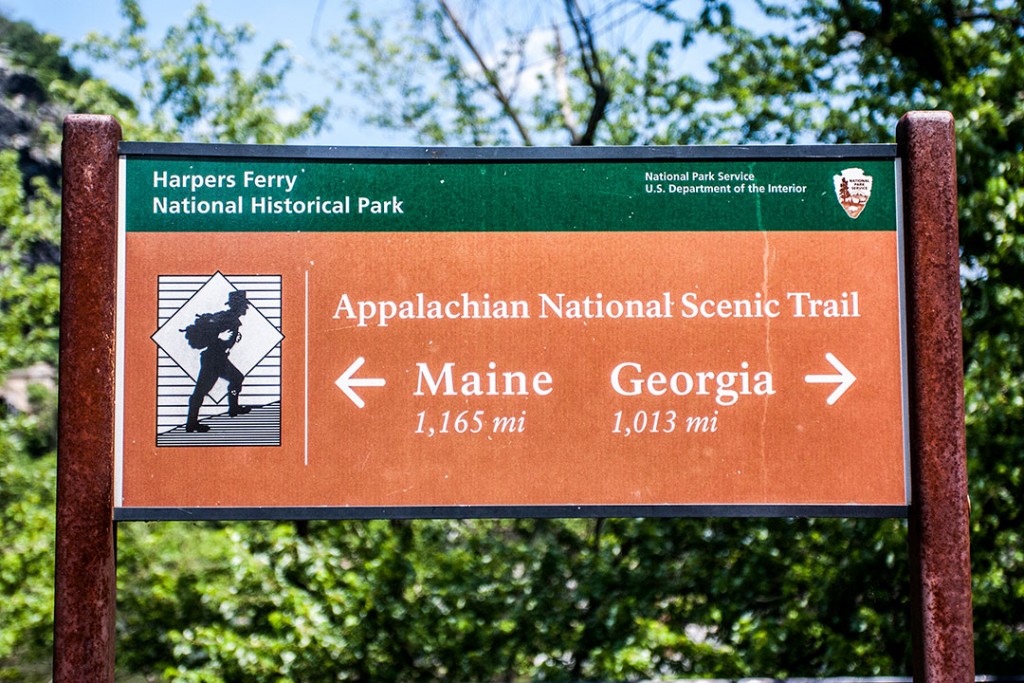
When to Start There are many ways to construct a flip flop hike which the ATC outlines in fantastic detail . However, one of the most common examples has hikers starting near the A.T. halfway point in Harpers Ferry during May and hiking north reaching Katahdin by August or September. Hikers then return to Harpers Ferry and hike south intending to end their hike on Springer Mountain by November or December.
- Allows hikers to start off with the easiest terrain the trail has to offer with Maryland and southern Pennsylvania.
- Trail crowding is a non-issue.
- Hikers can get through the Mid-Atlantic states before peak summer temperatures arrive.
- Pleasant hiking temperatures for the White Mountains in July.
- Encounter early-bird northbound hikers during the first half of the hike and end your hike with southbounders.
- Miss peak mosquito season in the Mid-Atlantics and black fly season in Maine.
- Fall colors are in full swing by the time hikers reach the Virginia and the southern Appalachians.
ARTICLE: Alternative Thru-Hikes on the Appalachian Trail ARTICLE: 10 Reasons You’ll Love a Flip-Flop Thru-Hike ARTICLE: The Path Less Traveled ARTICLE: Flip-flop, Leapfrog, NoBo… the AT choices
Navigating the Trail
The A.T. is considered to be among the longest continuously marked trails in the world. An estimated 165,000 white blazes guide hikers along the 2,189 miles of trail. A “white blaze” is a 2 x 6 inch swatch of white paint typically placed on trees, rocks, sign posts, and various other locations signifying the path of the A.T. White blazes are also marked for both northbound and southbound travel. The distances between white blazes vary, but are generally not too far apart. However, The ATC recommends that if you have traveled more than a quarter-mile without spotting a white blaze hikers should retrace their steps until a blaze can be located.

A typical white blaze on the A.T.

A typical double white blaze signifying an abrupt direction change or trail intersection.

A double white blaze signifying a left turn on the trail.

A typical rock cairn as seen in the White Mountains.
In areas where painted blazes are inappropriate or difficult to see, rock cairns are a common substitute. A “cairn” is simply a small pile or stack of rocks and stones marking the path of the trail. While less common then white blazes, cairns are heavily relied upon in certain sections of the A.T., such as in the White Mountains of New Hampshire.

A typical blue blaze found along the A.T.
Side trails that connect or intersect with the A.T. are marked with blazes of other shapes and/or colors . These side trails are commonly referred to as “blue blazes,” as they are often marked by painted blue-colored blazes reminiscent of the A.T.’s white blazes. Side trails can include spur trails leading to A.T. shelters, water sources, vistas, or a plethora of other destinations. Many blue blazes will be marked with signs at their intersection with the A.T. noting their destination. Otherwise, it’s best to consult a map or guide book to verify a side trail’s destination before leaving the A.T.
ARTICLE: The Best Blue Blazes on the Appalachian Trail – Part 1 ARTICLE : The Best Blue Blazes on the Appalachian Trail – Part 2 ARTICLE : The Best Blue Blazes on the Appalachian Trail – Part 3 ARTICLE : The Best Blue Blazes on the Appalachian Trail – Part 4
In rare occasions, hikers will need to ford streams, creeks, and rivers. This is particularly true in Maine. Most fords are easily manageable and do not pose significantly elevated risk. However, during and after heavy rains fords should be assessed with caution. Several crossings will be equipped with ropes to help guide hikers through the ford as well as provide a source of balance.
There is only one river hikers are advised to never ford–the Kennebec River in Maine. The Kennebec is the widest unbridged crossing on the trail measuring over 200 feet. Random water releases from a dam located up river can cause water levels in the Kennebec to rise quickly and unexpectedly. Though water releases may be infrequent they can occur with little to no warning down river. Fortunately, the ATC and the Maine Appalachian Trail Club help fund a ferry service to safely carry hikers across the river. It is highly recommended that all hikers please use the ferry service to cross the Kennebec River to ensure their own safety. You can find more information on the Kennebec River ferry services in the articles below.
ARTICLE: Crossing the Kennebec ARTICLE: Kennebec River Ferry Service ARTICLE: How the AT Works: River Crossings
Guidebooks & Maps
While the signature white blazes go a long way in guiding hikers along the A.T., it is highly recommended that all hikers consult and bring guidebooks and/or maps with them when setting out on the trail. Both maps and guidebooks are invaluable resources for any thru-hiker, each with their own pros and cons.
Today guidebooks are a more popular choice among A.T. hikers over traditional maps. They provide extensive and practical information about not just the A.T. itself, but also its surrounding businesses and communities all contained in one small, easily affordable package. Also because the A.T. is so well marked and maintained most hikers do not require a traditional map to safely navigate the trail. Still, guidebooks rely on a hiker’s ability to follow the white blazes and stay on the A.T. Hikers who venture off trail or get lost will find the guidebook to be of little assistance beyond maybe a few helpful phone numbers (if you have signal) and as kindling.

There are two prominent guidebooks utilized by most A.T. hikers: The A.T. Guide by David “AWOL” Miller and the Appalachian Trail Thru-Hikers’ Companion by the Appalachian Trail Conservancy and Appalachian Long Distance Hikers Association (ALDHA). Both guides offer a wealth of information about the A.T., such as elevation profiles of the entire trail, mileages, shelter locations, water sources, town maps, contact info for hostels and outfitters, and much more. However, guidebooks do not show a general overhead view of the trail’s path as would be found on a traditional map. Even so, both The A.T. Guide and the Appalachian Trail Thru-Hikers’ Companion are excellent resources to help hikers throughout their A.T. journey. If you need help deciding which guidebook is for you check out the article below for a helpful comparison.
ARTICLE: The AT Guide vs. The Thru-Hiker’s Companion
Traditional maps, while not as detailed as modern guidebooks, still provide valuable information. They give hikers an overview of their surroundings in a way guidebooks are not equipped to do. They allow hikers to view a better lay of the land by showing surrounding topography, providing insight on the paths of relevant side trails & forest roads as well as better insight into the location of the A.T. in relation to the surrounding area. Unlike guidebooks’ ability to contain all its information in a single bound volume, it’s impossible to have a detailed view of the entire trail on a single map. If hikers wish to have maps for the entire A.T. they can expect to have to purchase many maps for the different sections of the trail .

Which Should I Choose?
This decision is ultimately one of personal preference. Guidebooks are generally cheaper, heavier, and provide mountains of useful information. Maps are generally more expensive, lighter, and gift a view of the trail that guidebooks cannot. If it can be afforded, carrying both is also a valid option as both resources compliment each other well.
Camping & Shelters
It should be no surprise that sleeping out in the woods is a regular part of any thru-hike. While traveling the A.T hikers will generally have two primary options to choose between when it’s finally time to settle in for the night: utilize one of the established A.T. shelters or resolve to set up their own traditional campsite.

Like much of the A.T., shelters are built and maintained by local volunteer trail clubs. Shelters vary in size with some holding as few as 5 hikers and others as many as 20. However, shelters operate on a first-come-first-serve basis and are open to all A.T. travelers, not just thru-hikers. That means if a shelter is full by the time you arrive you’ll need to either pitch your own tent or hike on to the next available campsite.
Additional amenities at shelter sites vary as well. Some may be equipped with an adjoining picnic table, established fire pits, bear-bagging systems, and privies. Also many, but not all, shelter sites are equipped with additional space for tent camping should the shelter itself already be full for the night. However, shelter life doesn’t come without its issues, so here are some things all hikers should consider before taking up shelter space.

- The majority of A.T. shelters are free to use. Yet, there are some that require a small fee. Such shelters tend to be found in high-use areas and often have an on-site caretaker.
- Shelters’ convenient locations along the trail coupled with their many backwoods “luxuries” make them popular stops for A.T. hikers. Many thru-hikers utilize them as checkpoints for lunch breaks or for ending a day’s hike. As a result they tend to become social hubs for hikers, particularly if you are traveling a typical northbound hike. This makes shelter sites a great opportunity to meet and engage with other hikers.
- Bring ear plugs. If you intend to sleep in shelters expect to deal with other hikers’ night-time quirks, such as snoring, sleep talking, and even night-terrors.
- Sleeping in a crowded shelter can be aptly compared to sleeping in a sardine can.
- Shelters are highly sought after on rainy days and nights as their overhanging roofs often provide the best protection from the elements on the trail. As a result they tend to fill up fast when it starts to get a little wet.
- Many shelters have become a hub for rodent and pest activity. Years of hikers cooking/eating inside/around shelters has attracted resident mice and other critters bent on getting into your packs and food bags.
- Do not assume you will be able to sleep in a shelter every night on the A.T. Many circumstances may arise that can make shelters innaccesible or unavailable. Therefore, it is important to be able to supply your own shelter in these situations.
For a better view of shelter locations along the trail check out our Interactive Map of the A.T .
ARTICLE: Shelter Etiquette on the AT
If an established shelter is full for the the night or if shelter life just isn’t your thing, then you must rely on traditional camping. According to the ATC there are at least 100 designated campsites scattered along the A.T. in addition to the camping available near shelter sites. Much like shelters they are often positioned close to a water source but tend to lack other amenities found at shelter sites. Though some more well-traveled campsites may come equipped with wooden tent platforms and in a few cases also privies. Some campsites located in high use areas may also require a small fee.
Apart from designated sites there are areas along the trail where hikers are allowed to choose their own campsites. This practice is known as “dispersed camping.” While the term essentially describes the practice of setting up camp wherever a hiker wants, hikers will often find popular “established” dispersed camping sites that have been regularly used by hikers in the past. Popular dispersed campsites are often marked in A.T. guide books. If at all possible it is desired for hikers to reuse existing campsites as opposed to clearing new ground to establish a new sites.

Photo credit G N Bassett . CC BY-ND 2.0 .
While permitted in some form in many areas along the trail, the rules and regulations regarding dispersed camping vary depending on what state, town, or park you’re within the boundaries of. The A.T. runs through lands managed by a plethora of different agencies making identifying camping regulations sometimes difficult. For example, dispersed camping is strictly forbidden within the Great Smoky Mountain National Park. All hikers are required to stay at designated shelters and campsites only. Similar regulations apply in places like New York, New Jersey, and the White Mountains in New England. There are also some areas that may permit dispersed camping but limit the use of campfires outside of established pits.
It is the responsibility of each individual hiker to be aware of the regulations of the various areas they travel through. The ATC organized this useful spreadsheet outlining camping regulations in different areas on the A.T. If a specific area has imposed regulations on dispersed camping they are likely a safety effort, a conservation effort, or both. Limiting dispersed camping in well-traveled areas minimizes damage to the trail and its surrounding areas. If at all possible it is highly recommended to avoid clearing new areas by always trying to use established campsites, whether they be designated or dispersed. Doing so helps to preserve the ecosystem of the trail for the enjoyment of those who follow behind you.
ARTICLE: ATC Spreadsheet on Camping Regulations
Overnighting in the White Mountains
New Hampshire’s White Mountains are the most anticipated section of the trail for many thru-hikers. Notable for both its awe-inspiring beauty and notoriously challenging climbs, the White Mountains also add a another logistical challenge for hikers to contend with as camping becomes a little more complicated. First off, the A.T. in the Whites passes through many Forest Protection Areas (FPAs) – areas designated by the US Forest Service as “high use” that need protection from overuse. FPAs include any areas in alpine zones above tree line, around shelters, huts, and all other places where over-camping is considered a problem such as by roads, ponds, and other fragile ecosystems. As a result camping of any kind is prohibited in these areas.
To help prevent camping in FPAs there are there are 13 conventional shetlers and designated campsites found within the Whites hikers can utilize. However, in both instances, because of their high use, most shelters and campsites in the Whites are accompanied by a caretaker and often require a small fee in order to use (so make sure you have cash). Not to mention some of these campsites and shelters can be upwards to a mile detour off trail in some instances. In addition, the distance between the shelters can also be quite large at times. For example there are over 40 miles separating Ethan Pond Shelter and Imp Campsite Shelter as the trail passes over the Presidentials. As a result thru-hikers have come to rely on the Appalachian Mountain Club (AMC) hut system as an additional lodging option through the Whites.
The AMC operates 8 huts along the A.T. through the White Mountains. These huts do not operate like conventional shelters. These huts are staffed by AMC crew members who provide lodging, home-cooked meals, and educational programs for paying guests. For thru-hikers to earn a place at one of these huts requires either a reservation with a substantial fee or a work-for-stay agreement with the hut’s crew. Given the fluctuating nature of a thru-hike it is highly unlikely a thru-hiker will be successful making and keeping an advance reservation (much less want to pay for it). Rather most thru-hikers will rely on the work-for-stay option, but this is by no means a guarantee either. Work-for-stays are first-come-first-serve and are entirely up to the discretion of the operating crew. Also space available for work-for-stay hikers is very limited with each hut usually accepting only 2 – 4 hikers per night. Naturally there are some exceptions. In special circumstances a hut may welcome in more hikers, such as during bad weather. Also Lakes of the Clouds hut has a basement shelter called “The Dungeon” where hikers can pay $10 for a bunk.
Hikers can expect to do a couple of hours work to earn their stay whether it be sweeping, washing dishes, scraping ice out of freezers, or any other chore the crew deems necessary. In the end your hard work is rewarded with whatever delicious food the paying guests did not eat and a warm spot on the hut floor for the night.
Snagging a spot in a hut is one part planning and one part luck. Most huts will not start accepting work-for-stay hikers until close to 4:00PM, so you don’t want to end your day at a hut too early or the hut crew may turn you away. However, you also don’t want to arrive too late or other hikers may have taken all of the available spaces. So if you’re plan is to end you night at an AMC hut be sure to strategically plan your arrival.
Because of there is no guarantee at a spot in an AMC hut, hikers should ensure they have a backup plan in case they miss the window to snag a work-for-stay. It is a realistic scenario for hikers to have to continue on to the next hut, shelter, or campsite down the trail.
ARTICLE: A Thru-Hiker’s Guide to the AMC Hut System
Water is the most important resource thru-hikers must learn to manage on the A.T. Usually water is easy to find on the trail. As hikers meander through the woods they’ll cross numerous fresh springs, streams, ponds, rivers, and lakes from which they can draw water. It is not uncommon for hikers to pass multiple water sources in a single day. Shelters and popular campsites are also usually positioned within reach of a viable water source. Both guidebooks and some maps will mark the locations viable water sources for hikers to take advantage of.
It is important to note that water sources listed on maps or guidebooks can sometimes dry out in drought conditions. While this is atypical, local climate and weather conditions can affect the availability of water on certain areas of the trail. If there is a problem area displaying uncommonly low water levels local rangers, and even the ATC, will try to post alerts to keep hikers informed.
How Much Should I Carry?

Photo credit Staffan Evardsson . CC BY 2.0 .
How much water hikers need to carry at a given time depends mostly on the number of water sources available on a given day. Crossing fewer water sources necessitates carrying greater amounts. However, if water on a given day is abundant it becomes more a matter of personal preference.
Water is one of the heaviest items hikers have to carry weighing in at approximately 2.2 pounds per liter. As a result carrying more than is needed can really weigh you down. A general estimate is that hikers will have to carry anywhere between 1 – 2 liters of water. It’s unlikely most hikers need to carry more than 2 liters at a time except for in special circumstances.
In general hikers new to the trail will likely need more water than more seasoned backpackers until their body adapts to the trail. Even so newbie hikers still tend to carry more water than is necessary. With time every hiker will begin to identify their hiking preferences and find their preferred method for handling their water needs.
That being said, thru-hikers often suffer from chronic dehydration due to the incredibly high levels of activity they exert every day. It simply becomes more difficult to sufficiently drink enough water stay well-hydrated in these conditions. If you feel thirsty it means you are already dehydrated. Therefore, it is best for hikers to continually drink water throughout the day, particularly in warmer weather, to help avoid more serious health complications associated with dehydration.
With any open backcountry water source there is an inherent risk of contamination. The water found along the A.T. is oft not swimming with parasites, but the obvious problem with viruses and microscopic organisms is that you can’t tell if they’re there just by looking. When most people speak of water-borne illness on the A.T. they are likely referring to giardia: a microscopic parasite that can cause severe nausea and diarrhea among other symptoms dangerous in wilderness settings.
It is highly recommended that all hikers carry with them some form of water treatment method. These typically come in the forms of either a filter or a chemical treatment. Both methods are equally effective and are much more enticing options than boiling all of your water one pot at a time. Which method you choose is a matter of personal preference, but here is a list of general considerations:
- Preventative measure: filters out particulates and pathogens from collected water.
- Often heavier (depending on the model)
- Usually requires more physical effort in the form of pumping or squeezing.
- Water is drinkable immediately after it’s filtered.
- May require regular maintenance to maintain effective functionality (depending on model).
Chemical Treatments
- Reactive measure: kills pathogens in collected water through chemical reactions.
- Typically lighter
- Most common types are chlorine drops or iodine tablets.
- Does not keep particulates out of water.
- Usually requires time to fully treat water before drinking. Typically 10 – 30 minutes depending on the amount of water being treated.

Understand that drinking unfiltered/untreated water does not guarantee you will become ill. There are hikers every year who travel the trail who never treat their water and never get sick. Some of these hikers may have adapted resistances to certain infections or may actually have a more robust immune system, but most are simply just lucky.
We understand that treating water can often become a tedious camp chore prompting many hikers to, at some point, try unfiltered water to save time and energy. Much of the time you may be able to squeak by as healthy as ever, but it only takes one time to put you in a world of discomfort. Even so, should you run into a situation where you need water and are unable to access a recommended treatment method (or if you’re just being complacent and lazy) you can sometimes determine the level of risk a water source poses by a number of objective factors.
- Giardia in particular is a parasite that lives in the guts of people and animals passing via feces. Though all backcountry water sources may be potentially harboring giardia cysts, lower-lying water sources near farmland or in areas with higher access to animals and runoff may pose a greater risk of contamination.
- Water-borne pathogens tend to attach themselves to suspended solids and other floating particles present in the water as opposed to just swimming around freely in the liquid. As a result the less dirt and particles in your water the less likely it’s going to make you sick. Granted, this is very much a “rule of thumb” estimation.
- Drawing from a flowing, moving water source is always better than drawing from still water. Still water runs the risk of stagnation and is more likely to contain parasites and waterborne illnesses.
ARTICLE: Should You Treat Backcountry Water? What the Science Says. ARTICLE: Water Treatments for Backpacking and Hiking ARTICLE: About Water ARTICLE: How to Survive Waterborne Diseases on the AT
Preparation
To say hiking the entirety of a nearly 2,200 mile trail is a monumental undertaking would be an understatement. Trying to prepare for such an endeavor can get a little overwhelming at times. How do you properly plan out 4 – 6 months of living in the woods? Well that depends a lot on the kind of person you are. Some people are planners and some people just like to go with the flow. However, heading out onto the trail having done little to no planning or research whatsoever is a recipe for failure. At the same time, being unable to alter or adapt your plans throughout your hike may lead to the same end. As a result the closer you fall to the middle of the spectrum between being a control-freak and a master of free-flow probably the better.
How do I find the time and money?
A free six months doesn’t just happen, nor does a spare $5,000. Thru-hiking requires a decision, a commitment, and a conviction. Most thru-hikers are not wealthy, nor are they without personal responsibilities, loved ones, and businesses that depend on them. Many hikers quit their jobs, get out of leases and sell their stuff or put it in storage, and make the difficult decision to put their normal relationships with loved ones on hold for a half year. It’s not easy, but it is possible. It all starts with a decision.
It’s not easy for most people to find a spare $5,000 or put their lives on hold for six months. But whether you make $20,000 or $200,000 a year, the decision to hike the Appalachian Trail is going to require the same thing: a huge commitment.
If you want to hike the Appalachian Trail, you can’t define it as a vacation . You will need to consider it a lifestyle change. This is a six-month journey; for most people, it is not a dream that can go from inception to reality in a matter of weeks or months. It will most likely take years of saving, planning, and balancing of your personal life.
For different people, each sacrifice is going to carry a different weight. People who have debts or undefined career paths might find it harder to accumulate the savings. On the other hand, people who have established careers, houses, and/or families will most likely find it hardest to get the time for a thru-hike. Whatever your responsibilities are, to plan a thru-hike requires patience – and flexibility. You will need to be able to look ahead at the next few years (or even decades) and make a plan based on where you will be with your job, how your family is going to feel, and what you can save in that time period. But, you will also need to be able to throw that plan away and jump at the opportunity to hike if it appears in the form of an unexpected lay-off or your high schooler suddenly suggesting that you hike together.
ARTICLE: 13 Unlikely AT Hikers (If They Can, You Can)

Creating a rough itinerary of your trip can go a long way in helping to understand the trail and the kinds of challenges you could face on a thru-hike. Before you can get to working out a rough plan for your hike there are a couple foundational questions you should answer first:
- What is my time frame? If you know you don’t have a strict schedule then you may be able to more freely choose how you wish to experience the trail. However, a set deadline may limit your options. For example, if you are in school until late May then a Northbound thru-hike may be hard to manage as you won’t be able to start until too late in the season. Regardless, knowing your time frame makes the next question that much easier to answer.
- When you can start.
- When you must finish.
- What seasons you’ll hike through.
- Weather & temperature expectations.
- Number of other thru-hikers you’ll encounter.
Having the answers to these two questions will provide the foundation for any and all of your future pre-hike planning. The rest is up to you. It’s your hike after all. Make it your own. Coming up with a hiking schedule is now just a matter of taking out your guidebook/maps and crunching the numbers.
Still, use the term “schedule” loosely. While having a schedule of sorts for your hike can be helpful in regards to planning mail drops and managing a stricter timeline it is not realistic to think that once you’re actually out hiking on the trail that you will be able to completely stick to your pre-made itinerary. Most people report their itineraries going out the window within the first few days on trail. Over 4 – 6 months it is impossible to predict all of the unexpected surprises that could cause you to have to alter your schedule. Hiking the A.T. often necessitates an air of flexibility to adapt to unanticipated circumstances. So if at all possible it’s a good idea to leave yourself some wiggle room, if you even feel the need to build an itinerary at all.
Registering Your Hike

Photo courtesy of kimmywashere .
Once hikers have committed to the idea of their thru-hike they can (and should) register their hike with the ATC. Registration holds the potential to help mitigate one of the most serious challenges facing the A.T. without the need for additional regulations. With the immense popularity of northbound thru-hikes over-crowding has been an unfortunate consequence. Crowding has started to cause undue stress to the trail and its environment resulting in damage to shelters and campsites, the trampling of local flora, trash build-up, and even harm or habituate wildlife. In addition, crowded conditions have also begun to negatively impact the A.T. experience sought by many prospective hikers.
Fortunately, with the new registration system hikers can now get a picture of when their fellow hikers are planning to hit the trail. Registration makes it is possible to see in advance around what times over-crowding is likely to occur. This allows hikers to better plan and space out their start dates to help alleviate these issues in turn helping to improve overall conditions for all hikers on the A.T. Currently thru-hiker registration is ultimately a voluntary venture, but given the benefits it can have for the trail coupled with the fact that it is completely free means there isn’t really a good reason not to. To find out more information or to register your thru-hike click through to the ATC’s thru-hiker registration page here .
Technically, no paid permits are required for hiker to “access” any part of the A.T. However, some paid permits and other fees are required for hikers to “camp” along certain sections of the trail.
Great Smoky Mountain National Park A backcountry permit is required to camp within this national park. However, thru-hikers may apply for a special Appalachian Trail Thru-Hiker Backcountry Permit . To qualify for this permit hikers must start and end their hike 50 miles outside of the park’s borders and must only travel along the A.T. while inside the park. Each individual thru-hiker requires a permit and each permit costs $20 a piece. Permits are valid for 38 days from the date of issue and give hikers 8 days to travel through the Smokys upon entering the park. Hikers are also required to always have a physical copy of the permit on their person while within the park. The easiest way to acquire a permit is via online registration and email here . However, hikers may also call the park’s Backcountry Office at 865-436-1297.
Shenandoah National Park (SNP) Backcountry permits are also required for thru-hikers traveling through SNP. However, unlike the Smokies no fee is required to obtain a permit. For thru-hikers the easiest way to obtain a permit is at one of the self-registration points at the northern and southern boundaries of the park along the A.T. However, permits can also be obtained at visitor contact stations during normal business hours or by mail from the Park Headquarters. You can find more information regarding SNP permits from the park’s website here .
Baxter State Park (BSP) Due to recent tensions between the thru-hiking community and BSP it is imperative that hikers understand and comply with the rules and regulations associated with the park. In an effort to help the park better manage the increasing numbers of A.T. hikers starting in 2016 BSP is requiring all northbound thru-hikers, section hikers and flip-flop A.T. hikers entering the park to secure an A.T. Long Distance Hiker Permit Card. At this time southbound thru-hikers are not required to obtain a permit. In 2016, there will be no limit to the number of permit cards available and their will be no cost to secure a permit. However, permit cards must be acquired in person . A.T. hikers will be able to obtain permit cards at the following locations:
- Park Headquarters in Millinocket
- The Appalachian Trail Lodge in Millinocket
- Directly from the BSP/AT Steward at Abol Bridge
- Katahdin Stream Campground in Baxter State Park
Permit cards will also be required for any long-distance A.T. hikers staying at the Birches shelters at Katahdin Stream Campground. Learn more here !

- The best way to get in shape for backpacking is to go backpacking! Take yourself on as many shakedown trips as you have time for. It doesn’t matter if they’re day-hikes, overnighters, or longer. Just get yourself out climbing mountains with your gear. These hike will help you to start identifying your physical limitations, test your gear, and gain you other valuable on-trail experience.
- Even if you can’t always make it out to the mountains find excuses to carry your pack around. Get used to what it feels like carrying a pack everywhere. If all else fails walk around your neighborhood or local parks with all of your gear slapped onto your back.
- Whether you’re a paragon of health or your fitness leaves something to be desired, when first setting out on the trail it’s wise to take things slow. The biggest mistake new hikers tend to make is pushing too hard too fast. Trying to push more miles than your body is ready for is just asking for injury. Start by only doing 7 – 12 miles gradually increasing your mileage as you go. Listen to your body and don’t let other hikers’ paces dictate yours.
ARTICLE: 5 Steps Toward Preventing Injury Before a Thru-Hike ARTICLE: 5 Benefits of Training Before the Trail ARTICLE: How to Prepare Your Knees for Long Distance Backpacking ARTICLE: Yoga Exercises for Hikers
Although hiking ~2,200 miles across North America’s oldest mountain range is a physical feat on par with few others, the old adage is true: thru-hiking is primarily a mental challenge . Considering that this website is based off a book on this very subject, we may be a bit biased in saying so, but mental preparation is the most important aspect in preparing for a thru-hike.
There are no shortcuts when it comes to preparing your head for a journey of this magnitude. We encourage you to read Appalachian Trials to best ready your mind. Below are just a couple of the more important areas to focus on prior to embarking.
Purpose: Knowing your purpose for thru-hiking is paramount. Whether it’s after a week’s worth of hiking through rain or battling a debilitating case of blisters, there will come a time when you will ask yourself, “why am I doing this?”. Those without a convincing answer are far more likely to vacate the trail.
Expectations : Those who go into a thru-hike expecting a half-year vacation are also at high risk of falling short of their goal. Although thru-hiking very well can be the most exciting half-year of one’s life, there will be many days which are the furthest thing from fun. It’s likely that hikers will sustain their own set of “trials” such as injury, illness, loneliness, severe discomfort, dehydration, malnourishment, and boredom, just to name a few. Knowing how to cope with these challenges will make or break one’s success in attempting a thru-hike.
ARTICLE: The Virginia Blues BOOK: APPALACHIAN TRIALS
How Much Does It Cost to Thru-Hike?
There are a lot of factors to consider when trying to determine how much your thru-hike will cost you. Running out of funds is a common reason many thru-hikers have to end their hikes early, so adequate forethought and planning is important to ensure you stay financially afloat during your adventure. A common average quoted by many is that it costs $3,000 – 5,000 per person to hike the trail. However, this estimate does not include initial gear purchases and other financial commitments outside the scope of the A.T. It’s very possible to spend far less or to far exceed this range depending on your specific needs and desires. A thru-hike can be done on a minimal budget, but doing so involves sacrificing many potential in-town luxuries that may be hard to pass up. Here are some questions to consider when looking at the finances of the trail:
- How much gear do you need? Gear is easily the most expensive upfront cost for planning a thru-hike. If this is your first trail then you may need a lot of gear. Look for ways to minimize your costs by entering sponsorships, taking advantage of sales, buying used gear, or even making some of your own DIY items.
- Can you minimize your financial commitments before setting out on the trail? If so, do it. The fewer bills you have to keep track of while hiking the more rested your wallet (and mind) will be.
- Do you need/want insurance coverage while hiking. If you don’t have any coverage provided by family or an employer, travel insurance is a cheap and viable option for covering your hike.
- How likely are you to stay in town? Town stays and visits can eat through your funds quickly be it dining in restaurants, paying for shuttles, or staying in hostels and hotels. Could you sacrifice any of these luxuries even on an occasional basis?
- Do you plan to take any excursions off trail? Do you want to visit any tourist spots? Take a trip into New York City, perhaps? Then makes sure you can fund such ventures.
- Do you have enough set aside to cover potential injury or illness?
These are but a small sampling of the things that may affect your finances. There are many different strategies and different outlooks on the subject. Consult the articles below for more insight on A.T. finances:
ARTICLE: 18 Ways to Prepare Your Wallet for Your Thru-Hike ARTICLE: A Guide for Cheap & Affordable Hiking Gear ARTICLE: Stretch’s Money Spent & Miles Hiked on the Appalachian Trail ARTICLE: 15 Essential Thru-Hiker Items for $25 or Less ARTICLE: Thru-Hiking for Frugal Bastards ARTICLE: How to Platinum Blaze: The Chronicles of Squirt
It’s important to remember that while we thru-hikers like to joke about being filthy vagabonds and sometimes act like we’re practically homeless, the reality is usually the opposite. Many thru-hikers are far from homeless and people familiar with the trail know it. Adequately preparing for the A.T. means adequately preparing your wallet insofar as possible, not just your body and mind. While most hostels and outfitters can in some capacity understand that a thru-hikers budget is sometimes tight, they are businesses who do not always appreciate being asked for discounts and handouts. The burden for financial stability is on us: the hikers, not the businesses and services we wish to use.
Figuring out gear for your thru-hike is one of the most fun—and time-consuming—aspects of your preparations. The options are infinite and the choices can be overwhelming to those unfamiliar with long-distance backpacking. The best thing you can do is research. Read articles. Talk to former and future hikers. Visit outfitters and ask questions. Here are some links to get you started.
ARTICLE: The Thru-Hiker’s Suggested Gear List ARTICLE: How to Pack for an Appalachian Trail Thru-Hike ARTICLE : Base Layers for Hiking: What You Need to Know
The Big Four
While everyone’s specific gear will vary, there are a few things that every hiker needs: a backpack, a sleep system, a shelter, and footwear. Known as the “Big Four,” these pieces of gear are often considered the most important (and often most expensive) in every hiker’s arsenal. For smaller pieces of gear it’s not as big a deal if you need to replace or switch out items mid-hike, but the Big 4 you want to try and get right the first time if you can. Otherwise you can expect both physical, mental, and financial repercussions seeking replacements.
It should go without saying that every backpacker is going to need a backpack. Your backpack is, of course, the tool that allows you to carry all of your belongings with you as you trudge over mountains. It’s your both your best friend and your livelihood on the trail, so you always want to make sure its got your back. An ill-fitting backpack can lead to a number of problems leading to severe discomfort and both back and shoulder pain. Therefore you want to find the backpack that fits you and your gear the best. This means getting properly measured and fitted. This can be most easily accomplished by visiting a local outfitter. Any outfitter selling packs should have staff capable of properly fiting customers. However, due to their nature some bigger chain outfitters may be less knowledgable.
If you go into a thru-hike with a pack exceeding 65 liters, odds are, you’re going to end up buying a new pack. Many big box outfitters are going to try and talk you into a larger pack than you need. If you can fill a 75 liter pack, you’re carrying too much stuff. Likely an even smaller pack will best suit your needs, but that will depend largely on the compactness of the rest of your gear. A high loft, down sleeping bag will go a long ways to opening up space in your pack, as will carrying the clothes that you need and nothing more. Also remember to include the actual weight of your pack into your overall gear weight calculations. For a thru-hike you won’t need a pack weighing much over 3.5 lbs. max.
Companies like Osprey , Gossamer Gear , ULA Equipment , and Granite Gear all make great packs for thru-hiking.
ARTICLE: By the Numbers: Backpacks on the AT ARTICLE: Backpacks: How to Choose
Being able to get a good night’s sleep on the trail is imperative to your health and happiness. Finding the right sleeping bag + sleeping pad combo for you is crucial. Naturally, sleeping bags designed for backpacking are a bit different than those you might take to a friend’s sleepover. They need to be light and packable. Should you get a down or synthetic bag? Should you get a sleeping pad at all? If so what kind? Do you need a bag liner? All of these are excellent questions that need answering, so follow the links below for more information on sleep systems. A few key points on your sleep system are below.
- NOBO thru-hikers leaving between mid-March to mid-April typically opt for a sleeping bag in the 15 to 20-degree range, and often switch to a cooler setup for the summer.
- Down offers a better warmth to weight ratio than synthetic but loses its insulation when wet. This is why a high-quality tent is crucial- to ensure your shelter remains dry at night, whether it be from condensation or shielding off rain.
- The higher a down sleeping bag’s loft, the better its warmth-to-weight ratio. 700 loft is good, 800 is great, 900 or more is excellent.
- Sleeping bags that use hydrophobic (i.e. waterproof) down are well suited for the AT’s damp environment. Common applications are DriDown and DownTek.
- Therm-a-rest makes great sleeping pads. We really like the NeoAir XLite , but Big Agnes also makes some popular inflatable options.
- Sleeping bag liners are great, but aren’t necessary. Their best feature is that they can absorb a hiker’s stank that would otherwise soaked up by your sleeping bag. Also a liner is easier to wash than your bag, which is a selling point not to be underrated. Although they do add insulation, ideally a hiker is carrying a sleeping bag suitable for the coldest conditions they’d encounter on the trail.
- Bag liners can make excellent substitutes for those summer nights where your sleeping bag is just too warm to sleep in.
Some sleeping bag brands we like are Marmot , Feathered Friends , Enlightened Equipment , Zpacks , Western Mountaineering and Kelty (for those on a budget). For those seeking synthetic options Mountain Hardwear makes some of the best and most packable on the market.
ARTICLE: By the Numbers: Top Sleeping Bags & Pads on the AT ARTICLE: Sleeping Bags for Backpacking: How to Choose ARTICLE: Sleeping Pads : How to Choose ARTICLE: Sleeping Bag Liners: How to Choose

Photo credit Matt M. . CC BY-NC 2.0 .
ARTICLE: By the Numbers: The Top Shelters on the AT ARTICLE: Tent, Tarp, or Hammock? A Flow Chart ARTICLE: Backpacking Tents: How to Choose ARTICLE: Hammocks : How to Choose
Much like the rest of the “Big Four,” hiking shoes can greatly affect the comfort of your hike. Blisters, bone bruises, twisted ankles, and sprains among other foot-related ailments can be caused by nothing more than ill-fitting footwear. Trail runners and hiking shoes have become a common choice for A.T. hikers, though traditional boots still populate the trail as well. Footwear is a deeply personal choice, more so than any other category. We encourage you to check out the “By the Numbers” article below to get an idea of what brands and models former thru-hikers have preferred, but the decision will come down to trying on the footwear to learn what best works for your feet. For deeper insight on finding the best footwear for you consult the articles below.
The hardest part about picking the right boots is that you probably won’t know for sure whether or not the shoes will work for you until you’ve actually bought them bought them and taken them on a few hikes. Trying them on in-store can only do tell you so much. So if you don’t have the money to keep buying new pairs of shoes we recommend buying your shoes at a store, such as REI , that has a forgiving return/exchange policy that will allow you time to test your footwear in the field and bring them back to try another pair if needed.
One factor to consider is that your foot is going to change during the course of your thru-hike. It will flatten and swell. For this reason most thru-hikers get shoes one size larger than they currently need to project for this change.
ARTICLE: By the Numbers: The Top Footwear on the AT ARTICLE: Are Trail Runners Superior to Trail Runners? ARTICLE: Hiking Boots: How to Choose
The best way to start finding the gear that works best for you is to start getting hands-on experience. Visit outfitters and talk to experts. Try gear out in the store. Once you buy it, take it out in the field and test it some more. More often than not, hikers have to work with their gear a few times in the field in order to formulate a proper opinion. This is where those trusty shakedown hikes can really come in handy. If you find out a piece of gear isn’t working for you, replace it! And don’t worry if you ending up disliking a piece of gear once you’re already out on the trail. One of the many outfitters along the A.T. will be happy to help you sort out your problem.
Get our full thru-hiker’s suggested gear list here .
Resupplying on the A.T. is actually easier then you might think. While the heart of the A.T. takes you through the Appalachian wilderness, it also takes you within practical distances from numerous towns and communities along the way. The A.T. takes hikers within reach of a town approximately every 3 – 5 days on average. These towns naturally serve as useful resupply points for tangible goods such as food and gear, but they are also helpful for restoring your physical energy and mental fortitude. Of course, it isn’t always necessary to go into town to resupply. Sometimes you’ll be able to achieve a successful resupply at a random gas station at a crossroads. Some hostels even keep themselves stocked with basic supplies for hiker resupply. Towns just tend to be more reliable and offer a greater variety. That being said all towns are not created equal when it comes to resupply. The quality and distance to grocery stores will vary from town to town and don’t expect every town to have an outfitter to satisfy your gear needs. This is where a guidebook can serve you well, as it offers maps of popular towns listing relevant local businesses for hikers.

Photo courtesy of Jennifer Henderson Williams
While not a necessary to stay supplied on the A.T., mail drops are still a common practice some thru-hikers utilize for resupplying. The concept is essentially a hiker packs desired supplies into a package and then mails said package to a specific destination ahead of them on the trail. The intention is that the hiker will then pick up the mailed supplies when they pass by the location the package was mailed to.
Mail drops require a lot of logistical preparation. Naturally, the more mail drops desired the more complex the logistics. Because post office’s will only hold packages for a limited amount of time hikers often must coordinate with family or friends back home to ship the boxes for them within the desired timeframe. Fortunately many outfitters and hostels along the A.T. offer to hold mail drops for hikers as well and will usually hold them for longer periods than the post office. These options are often better choices than the post-office itself as it also frees the hiker from the strict operation hours of the US Postal Service.
It isn’t wise to use mail drops to supply yourself with items that would be easily acquired from shops in trail towns. Mail drops are most appropriately used to help you resupply with items that are not easily accessible from the trail, such as prescription medicines, unique dietary needs, or just a special treat to lift your spirits.
Whether you need mail drops or not for your hike is highly dependent on your specific needs on the trail. Consult the articles below for more insight on if mail drops are for you.
ARTICLE: How Many Mail Drops Should You Send on the Appalachian Trail ARTICLE: A Guide to Mail Drops on the Appalachian Trail ARTICLE: The Best Towns to Send Mail Drops on the Appalachian Trail
Getting to Town
While the A.T. meanders straight through the middle of a few towns, these are few and often far between. Typically towns and other resupply points can be anywhere between 1 – 20 miles away from the trail. For towns a short distance off trail walking is a potential option, but is often highly undesirable for obvious reasons. Some hiker-friendly towns may feature local businesses that offer shuttles for thru-hikers for a reasonable fee (usually outfitters or hostels). A guidebook can help identify if such services are available in each town. Similarly there may be resident Trail Angels who openly offer shuttling services to hikers. Willing Trail Angels are often listed in some guidebooks as well as in certain outfitters along the trail.

Failing any other options many thru-hikers commonly resort to hitchhiking. However, this comes with a few considerations worth noting. First and foremost the act of hitchhiking is technically illegal in some form or another in all 14 states that A.T. passes through. More specifically TN, PA, & ME all have out-right bans on all forms of hitchhiking. Massachusetts only specifically bans the practice on turnpikes or highways. The remaining 10 states ban that act of soliciting a ride on/in a roadway implying securing rides from gas stations, parking lots, etc. is permitted. In many cases the actual laws for hitchhiking are vague and open to interpretation. For example, there is a lot of written language about not standing “in” the road to hitch but whether this also implies the side or shoulder of the road isn’t necessarily clear. In any case in most states along the A.T. the enforcement of hitchhiking laws are pretty relaxed. As long as you are not obstructing the flow of traffic, safely on the shoulder of the road, and an officer isn’t having a particularly bad day hikers can usually stick out their thumb with little fear of reprisal. However, some states have garnered a reputation for stricter enforcement than others, New York and New Jersey in particular.
Beyond the fear of legal issues there is an obvious level of risk with accepting rides from strangers. Most drivers near towns around the trail who would stop do so because they are accustomed to the sight of hikers near A.T. intersections. Many are former/future hikers themselves looking to help out fellow A.T. adventurers. Still, never feel like you have to get into a car with someone just because they are the first to stop. If you ever feel uncomfortable getting in a car with someone then don’t! Plain and simple!
ARTICLE: Hitchhiking Tips and Tricks to be Successful and SAFE!
Thru-hikers looking to take a night or two off from setting up camp can seek out one of the many hostels set up along the A.T. Hostels provide a nice middle ground offering more comfort than sleeping in a shelter or on the ground while remaining fairly inexpensive when compared to other lodging options in town.
Many hostels have become destinations that are looked forward to just as much as other parts of the trail. Every hostel has its own flare and personality often providing a memorable and unique experience for its guests. This is due in no small part to the cast of colorful characters who staff these establishments to offer weary hikers a welcomed respite from the trials of the trail.
Services commonly provided by hostels can include bunks or beds, showers, laundry, kitchen access, shuttling services, mail drop services, and much more. Some hostels even include breakfast or dinner with their stay. On average hikers can expect to spend anywhere from $10 – 50 to stay at a hostel depending on the location and services available. The exact services provided at each hostel will vary and some services may cost additional fees. Some hostels even double as outfitters and vice versa.
Some hostels may also offer work-for-stay opportunities for hikers in special circumstances allowing hikers to pay for their stay by doing chores and other tasks for the hostel. However, work-for-stay opportunities are not guaranteed to any hiker and are up to the discretion of the hostel owners.
Many hostels, though not all, exist primarily with the intention of providing services to A.T. hikers, particularly thru-hikers. As a result a number of hostels are not open year-round and tend to only operate during peak thru-hiker season. This means that hostel hours tend to cater toward northbound hiker schedules due to the immense popularity of NOBO hikes. This also means that the highest concentration of hostels are located in the southern portion of the trail, thinning out in the Mid-Atlantic, and resurging again somewhat in New England. Contact and service information for hostels can be found in the A.T. guidebooks .
ARTICLE: Hostels and Lodging Along the Appalachian Trail ARTICLE: A Thorough List of Hostels on the Appalachian Trail
Hostel Etiquette
Hostels may have ingrained themselves as a popular part of the A.T. experience, but unlike the rest of the trail you actually have to pay to experience them. While many hostels provide special services to thru-hikers it is important to remember that they are, in fact, businesses. Many hostels are run by former hikers so they tend to understand a thru-hiker’s budget, but at the end of the day a business needs to be able to turn a profit in order to survive. Hostel owners work hard to keep their businesses operating and they are likely not getting rich doing so. Hostels tend to be lower-budget operations that are run more out of their love for the trail and a desire to be around the trail community.
There are a few hostels that ask for donations rather than charge hikers a set fee for their services. These hostels should not be looked at as “free stays”. There are a number of legal reasons why a hostel may be donation based, but many of these hostel owners are simply generous people. Either way, thru-hikers should look to compensate the hostel and its staff in some way for any services rendered, no matter what. Anything is better than nothing.
Also, think twice about complaining or trying to haggle down hostel prices. First of all, the odds are the prices being haggled already undercut your other lodging options, so if you don’t want to pay then just pitch your tent elsewhere. Running a hiker hostel is not easy work. Think about how much time hostel staff spends giving shuttles, and about their water and electric bills from hikers using all of their utilities day and night. Respect their rules. If they don’t allow dogs there’s a reason, so try not to beg for an exception. If they don’t allow alcohol don’t try to sneak it in behind their backs. Don’t be loud, rowdy, and inconsiderate to its surrounding community. While you may get to disappear back into the woods the hostel will be left dealing with any messes your actions may cause. In recent years several popular hostels have closed their doors for good citing poor behavior from hikers as the primary reason for shutting down. An unfortunate precedent has been set. So, please treat hostels and their owners with the respect that is due them.
ARTICLE: Want to Work in a Trail Hostel? 4 Things You Should Consider First
In the broadest and most self-explanatory sense an outfitter describes any business capable of “outfitting” hikers with the gear they need to get out on the trail. Outfitters allow hikers to acquire, repair, or replace various items such as backpacks, bags, clothes, stoves, boots, hiker food, fuel, and everything else in between. Some outfitters may even offer additional services to thru-hikers including shuttles and accepting mail drops. There are a great number of outfitters accessible to hikers along the trail, most of which are strategically stationed in trail towns. However, every town along the trail does not house an outfitter. So be sure to take advantage of outfitters when you have the chance. Hiker’s equipped with a proper guidebook will find information for many of the outfitters within reach of the A.T. Generally speaking the highest concentration of outfitters found near the A.T. is located in the southern half of the trail. Nearby outfitters become more scarce in the Mid-Atlantic region and once again become more frequent in New England.
ARTICLE: A Thorough List of Outfitters on the Appalachian Trail
For a better view of where to find popular outfitters along the trail check out our Interactive Map of the A.T. .
Best Practices

ARTICLE: Thru-Hiker’s Code of Conduct
The phrase “hike your own hike”, often abbreviated “HYOH,” represents a pervading ideal in thru-hiking culture. It is a philosophy embraced by many to help improve every hiker’s personal A.T. experience while also representing a ethical code for how hikers should interact with each other and other members of the A.T. community. For many, hiking the A.T. is potentially a once in a lifetime experience. Therefore, it is each hiker’s prerogative to hike in such a way that they will not look back at their time on the trail with any regrets. The one proviso to this philosophy is that any method of hiking should not impose or negatively impact (insofar as possible) another hiker’s experience, and by extension other members of the A.T. community as well. In short, it means every hiker is entitled to hike their own hike up and to the point that it begins to negatively impact the experience of another hiker . HYOH is meant not only to help you improve your own A.T. experience, but also help other hikers to do the same. For a more in depth discussion on HYOH consult the article below.
ARTICLE: When HYOH Doesn’t Apply
Leave No Trace (LNT)
If there is anything in the outdoor community at large that could be considered a near universally accepted law-of-the-land it is the Leave No Trace principles. Created by the Leave No Trace Center for Outdoor Ethics these seven principles represent the best guidance to help minimize adverse impacts during outdoor recreation. While it is nearly impossible to realistically leave NO trace during your time in the outdoors the goal of these principles is to minimize the impacts you can have. These principles are designed not only to help protect, respect, and conserve the environments we visit, but also to respect the experiences of other outdoor enthusiasts. While there is no written law that forces hikers to follow LNT it is important to note that many wilderness and park authorities do ascribe to these principles and factor them into both their policies and regulations. It would do all hikers well to make themselves familiar with these principles so that they may understand how to responsibly enjoy the A.T. For a more detailed discussion of LNT and each of the seven principles click through the links and articles below.
LNT: THE SEVEN PRINCIPLES:
Plan ahead and prepare, travel and camp on durable surfaces, dispose of waste properly, leave what you find, minimize campfire impacts, respect wildlife, be considerate of other visitors.
ARTICLE: Leave No Trace on the AT ARTICLE: How the AT Works: What Happens AFTER You Poop in the Woods
Dangers / Risks
By most accounts the A.T. is not a dangerous place (at least no more so than anywhere else in the world). In someways it may even be safer than walking down a busy city street. However, that does not mean that hikers are completely free of the risk of illness, injury or even death. There tends to be a large gap between what people unrealistically perceive as threats on the trail and the actual threats. Much of this comes simply from inexperience and the spread of misinformation. Let’s examine a few common misconceptions, before discussing more serious things to watch out for.
Perceived Threats

This is not to say black bears do not pose any threat to humans. The creatures are most dangerous when hikers manage to come between a mother bear and her cubs. Also, hikers who do not properly manage their food storage run greater risk of an encounter.
In summation: while black bears are a seemingly threatening animal, they prefer to leave you alone and be left alone in return.

It may provide some reassurance to know that venomous snakes do not always use their venom in a defensive bite as they possess a finite amount at any given time. Expending this resource means the snake’s body must work to produce more venom. Venom is primarily used to help snakes immobilize prey and using it on something they know they are not/cannot eat (i.e. a hiker) is a waste of this resource. That being said any bite from a venomous snake should still be checked by a medical professional as soon as possible.
While accidental bites sometimes occur from an unfortunately placed footstep, most bites are the result of mishandling or unnecessary/unsafe interaction with snakes. As many snakes effectively blend into their surroundings, it is safe practice to closely examine an area before sitting down for a break or setting up camp. If you encounter a venomous snake it is imperative you not try to touch or move it, even if it is directly on the trail itself. Rather give it a wide berth. Allow it to move of its own accord or navigate around it at a safe distance. It is also not an appropriate solution to kill these snakes. They are an important part of the ecosystem surrounding the trail and help keep rodent and tick populations in balance. Some species, such as timber rattlesnakes, are even considered threatened or endangered in many areas. Remember, that when you are out on the trail you are in these animals’ homes and not the other way around. YOU are the guest .
Consult the articles below for more information.
ARTICLE: Snake Bite First Aid and Treatment ARTICLE: Snake Identification
People It’s true there have been unsavory characters associated with the A.T., but such characters are uncommon. Most people encountered on the trail are friendly and ready to share in their love of the outdoors. It is an unfortunate fact that people have been the victim of violent crimes on the A.T., but such incidents are extremely rare. In the A.T.’s entire history there have only been a handful of murders associated with the trail, most all of which were carried out by non-hikers. Relative to the murder rate for other places in the country the A.T. is actually one of the safest places you can be!
If you ever find yourself encountering someone on the trail you do not feel comfortable with, there are steps you can take to distance yourself from that person. If the person in question is a townie or stranger on the side of the road, you can just move on down the trail to leave them behind. If another hiker is making you uncomfortable, consider altering your hiking pace to increase the distance between you. Failing that, try spending time in town and hope they move on. Sometimes skipping some distance up the trail is even the safest course. It may complicate the logistics of your hike, but safety is always more important. There is also safety in numbers—find a friendly group of hikers to always have a few buddies nearby.
ARTICLE: How to Avoid Creepy Men While Hiking
Safety Concerns for Women …Are the same safety concerns for men.
Nature does not discriminate between the genders. Human danger on the A.T. is extremely uncommon and, in a community that polices itself, evaded quickly. There have been instances of women being attacked on the trail, but they are extremely rare. In truth, women are safer on the Appalachian Trail than they are in any city, or on any college campus.
Women’s safety is a frequent concern for family members because people love their wives, mothers, sisters, and daughters – but it’s a concern that is based on the idea that women are more vulnerable. The woods are one of the few places where this concern is not only baseless, but sometimes even problematic. For instance, to avoid posting on social media your location is smart, but to completely avoid telling other hikers what your plans are can leave you stranded in the face of more likely danger – injury and exposure to the elements. It’s not a bad idea for all hikers to consider the question, ‘if something were to happen to me right now, when would a search party find me?’
The Appalachian Trail is a community which serves an important role of support. For any hiker, male or female, you are safer trusting in each other’s best intentions rather than being divided by fear.
Actual Threats
Being Under or Ill-prepared Being underprepared is ground zero for many wilderness emergencies. Relatively speaking, the A.T. is a safe place, but not having the right gear, underestimating the weather, and generally not knowing how to handle yourself outdoors can compound the risks. You don’t need to be a wilderness survival expert, but you do need to know enough to understand why it’s unwise to hike into a snowstorm in the Smokies wearing four layers of cotton.

ARTICLE: Tiny Terrors of the AT: Everything You Need to Know About Deer Ticks and Lyme Disease ARTICLE: Report: Tick-Transmitted Powassan Virus “Worse Than Lyme Disease” ARTICLE: Deer Tick Virus May Be On the Rise Near the AT

ARTICLE: Keep Your Warmth: How to Avoid, Recognize, and Treat Hypothermia ARTICLE: Three Actual Threats on the Appalachian Trail (and how you can protect yourself)

Heat Exhaustion & Heat Stroke Hiking in the summer months, particularly through the Mid-Atlantic region, brings high temperatures and serious humidity. Heat exhaustion, often accompanied by dehydration, can occur when you’ve been exposed to high temperatures for too long. This tends to manifest as a feeling of extreme fatigue, headaches, and dizziness on top of other potential symptoms. If signs of heat exhaustion go untreated, the condition can become much more serious and turn into heat stroke, when the body loses its ability to regulate temperature control. This is a serious condition requiring immediate medical attention. Consult the articles below for more information.
ARTICLE: Heat Cramps, Heat Exhaustion, and Heat Stroke First Aid for Hikers ARTICLE: A Close Call with Heat Exhaustion
Should I Bring a Gun on the A.T.?
The short answer is no . There is nothing keeping people from bringing guns on the A.T., but the idea just doesn’t make sense for the average hiker. While some people feel more comfortable with a firearm on their person, there is no practical reason any hiker would need a gun on the A.T. Hunting on the trail is unreliable and impractical. It is also illegal in most areas near the trail. Guns are also quite heavy. Even a small firearm plus ammunition would account for a sizable portion of your pack weight. The A.T. also passes through 14 different states, each of which hold different laws and regulations concerning concealed carry and general firearm possession. Lastly, the A.T. community is made up of kind and friendly individuals. It is highly unlikely you would end up in a situation where you would require such a deterrent.
ARTICLE: Do You Need a Gun on the AT? ARTICLE: Seven Frequently Asked Questions Regarding Guns and Bears
Do I need an itinerary? Definitely not. In fact, any attempt at a daily itinerary will likely go out the window after just a few days. Hiking pace is too difficult to predict, and quite frankly, planning too much takes away from the spontaneity of a thru-hike. If you’re working with an aggressive strict deadline, this can change things, however you’d be more likely to follow a loose itinerary as opposed to a day-by-day mileage prediction.
Is it safe to hitchhike? Yes. No life action guarantees 100% safety, hitchhiking is no exception. However the stories of dangerous encounters while hitchhiking are extremely rare. Towns surrounding the AT are extremely familiar and friendly toward thru-hikers. Odds are, you won’t be their first.
- Appalachian Trail Conservancy
- WhiteBlaze.net
- TrailJournals.com
- The Best Appalachian Trail Books
- 21 Fascinating Facts About the Appalachian Trail
- 10 Fantastic Hiker Traditions on the Appalachian Trail
The A.T. community has a language all its own. Brush up on your terminology with our Appalachian Trail Glossary .
Do you enjoy this resource? Consider giving back by becoming a Friend of Appalachian Trials or with a new Appalachian Trials Tee .

How to prepare for your trekking adventure: our 10-step training guide
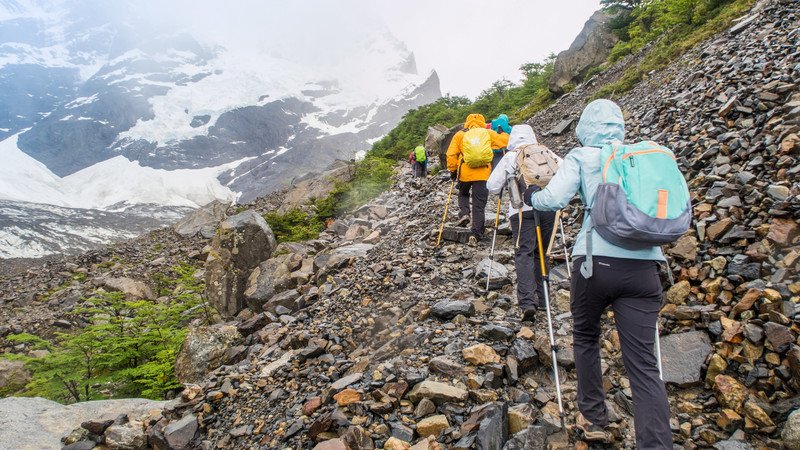
UPDATED: This blog was originally published on February 18, 2015.
Sure, you can turn up at the foot of Mt Kilimanjaro with nothing but a song in your heart and a pocket full of dreams. But you’re going to be in for a bit of a shock.
Without at least some pre-trip training, or a good basic level of fitness, trekking is hard work. Let’s be real – it’s hard work anyway. The toll for a great trek is paid in sweat. Sore calves and aching quads are badges of honour, with blisters and lost toenails marks of pride.
But in return, you get some of the most untouched, pristine and jaw-dropping scenery on the planet. And you know what? The more you train for your epic hike, the easier it’ll be.
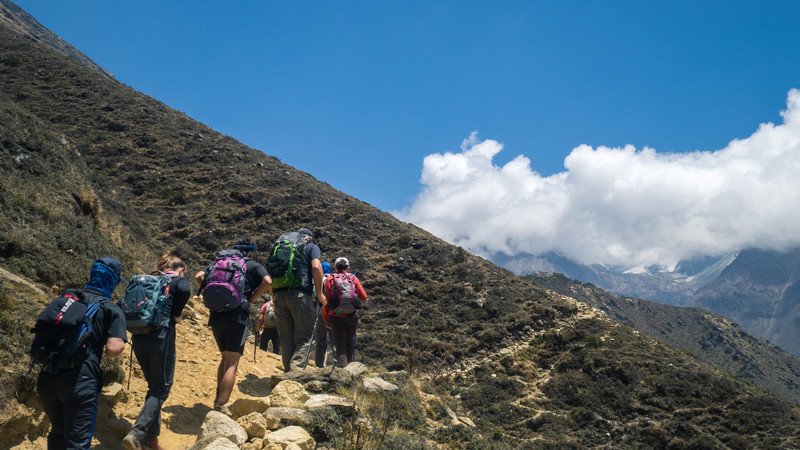
Photo by Kieran Wallace
And you don’t have to be an Iron Woman/Man to climb to Everest Basecamp or reach the top of Mt Toubkal . Far from it. Trekking is available to anyone; you just have to be sensible and work a bit for it. Here are a few of our top prep tips for your upcoming trek:
1. Start walking now (it’s never too early to start training)
This may seem like the most obvious step to start with (pardon the pun), but you’d be surprised how many people don’t do it. The best way to prepare for a really long walk? Do some really long walks. You should start with small-ish distances and work up to the length you’ll be trekking on your trip. When you start your training, leave a day in between each walk to let your body recover. But as your body gets fitter, try to do back-to-back sessions each day – it’ll help build your stamina for the relentless nature of a ten-day trek, where you won’t have the luxury of rest days. Ideally, you want to be able to walk 4-6 hours – comfortably – before you leave.
CHECK OUT OUR RANGE OF SMALL GROUP HIKING ADVENTURES HERE
2. Make leg-based cardio part of your routine…
As well as doing long walks, you should also work some leg-based cardio into your daily routine. Cycling is awesome for building up muscle in your legs, but soccer, football, squash and swimming are all great too. If you’re more into gym workouts, mix up your spin classes or cycling bursts with squats and lunges (the more weight, the better).
3. …and take the stairs every chance you get
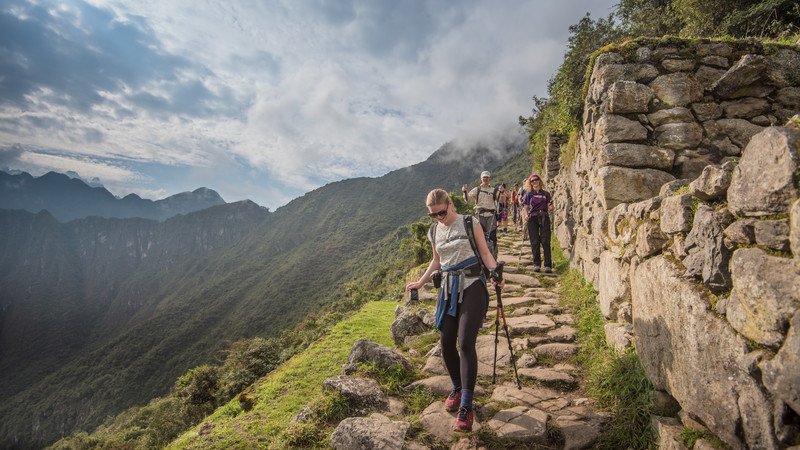
Photo by Patrick O’Neill
Stair climbing is also a good one for building up calves and quads, so take the stairs instead of the lift or escalator when you’re at work or the train station.
RELATED: WHAT I WISH I KNEW BEFORE TREKKING EVEREST BASE CAMP
4. Make sure you’re walking properly
You’ve been doing it since you were around one year old, but it’s super important to monitor how you’re walking and if you’re doing it correctly. Make sure you’re hitting the ground with your heel first, then rolling onto your toe, which propels you onto the next step (this will help reduce the risk of shin splints and tendon pulls – ouch). Walk with your head up, eyes forward and shoulders level.
5. Mix up your training terrain…
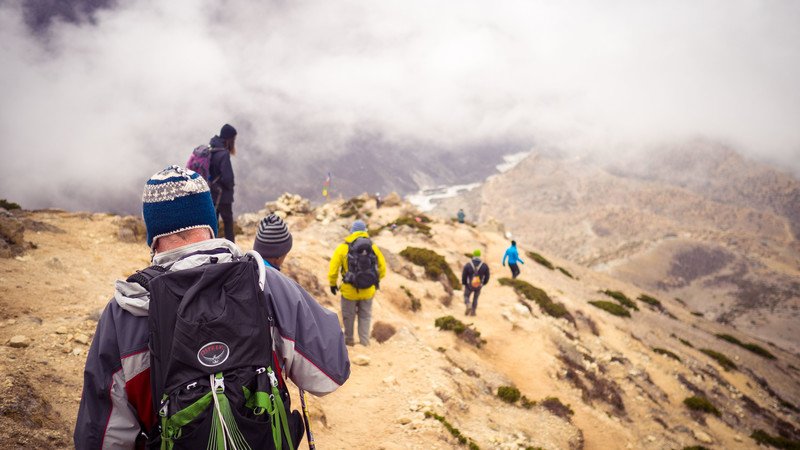
When you’re on your trek, it’s unlikely you’ll be walking on level footpaths and roads, so avoid training solely on level footpaths and roads. Instead, try to train on surfaces that will be similar to the trails on the trek. If you’re heading to Everest or Kili, aim to train on steep, rocky terrain and loose shale; if it’s Kokoda , try to find muddy paths. It’s really important you prepare your feet, ankles and knees for the stress they’ll experience on the trip.
RELATED: WHAT’S REALLY LIKE TO TREK THE INCA TRAIL
6. …and walk in all types of weather
It’s also unlikely you’ll get ten straight days of perfect weather on your trek, so prepare yourself for all conditions by walking in cold, windy, rainy, warm and humid conditions (where possible, of course!).
7. Try using walking poles
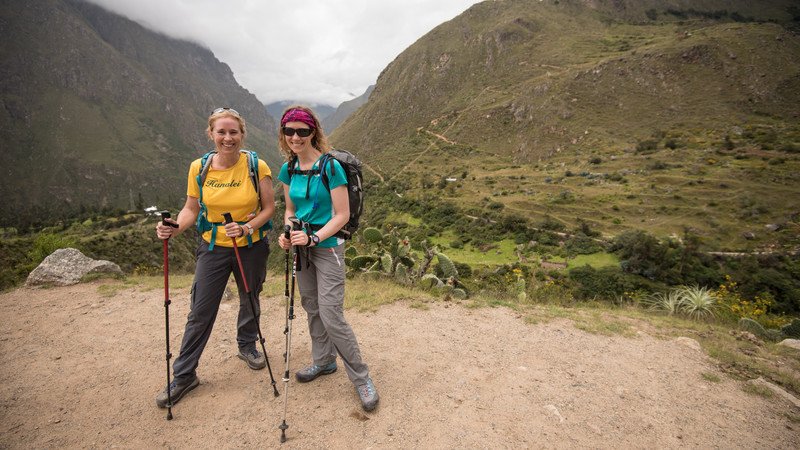
When you’re navigating Kili’s gravel trails or lumbering down Dead Woman’s Pass on the Inca Trail , walking poles will become your two new best friends. They take the pressure off your knees on the downs, and give you extra support on the ups. Incorporate poles into your training sessions so you get used to walking with them.
RELATED: TREKKING TO MACHU PICCHU? HERE’S YOUR ULTIMATE PACKING GUIDE
8. Train with a backpack
On almost all of our trekking trips, you won’t be carrying your main pack, but you will need to carry a small daypack, packed with essentials like your camera, snacks, sunscreen, water and wet-weather gear. So with all your days/weeks/months of training, make sure you’re challenging yourself with a weighted bag. If you really want to push it, pack your bag with a few extras, so it’s a little heavier than what you’re planning to hike with on the trip – it’ll make the eventual trek feel like a walk in the park (chortle).
9. Keep the tank fuelled
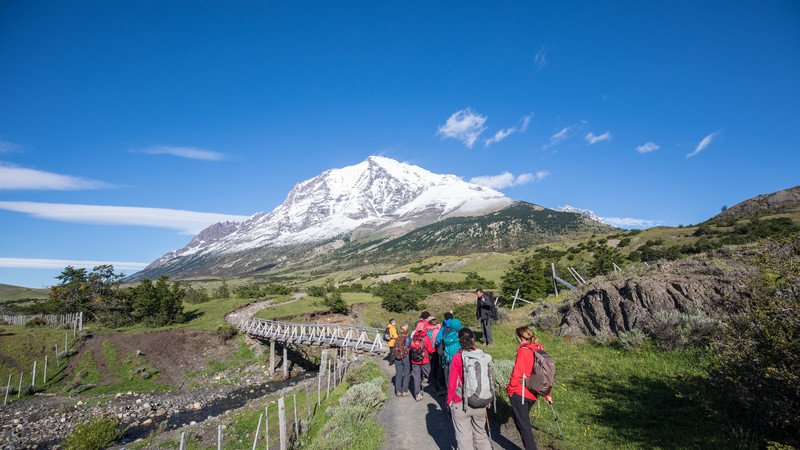
Photo by Miguel Gutierrez
It’s SO important you’re stocked with enough water and food during a trek (hydration is key!). Nuts, dried fruit, muesli bars and chocolate are all good, quick sources of energy and protein; keep a selection of these healthy snacks in your daypack. Also, bring along a reusable canteen; alpine streams are usually a great source of fresh water, but our guides provide boiled (and cooled) water daily throughout your trek. While you’re in training-mode, try to eat and drink ‘on the go’ as much as you can, so your body can get used to digesting during strenuous exercise.
RELATED: WE ASK A LEADER WHICH ROUTE TO TAKE UP MT KILIMANJARO
10. Invest in a good pair of shoes
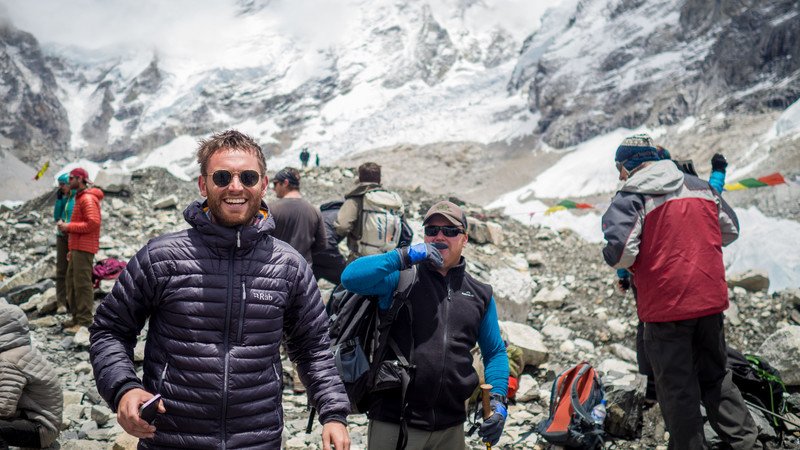
Your feet are your most crucial body part on a trek, and it doesn’t take much to keep them in toe-tappingly tip-top shape. First, invest in a pair of good-quality, water-resistant hiking boots; you want plenty of support and ventilation too. Then, wear them in. How do you do this? Wear ‘em everywhere. On your training runs, on walks to the shops, to work, to formal events (well, maybe not). You get the idea though; by wearing them in as much as possible in the weeks and months leading up to the trek, it’ll help avoid blisters, bunions and lost toenails. Then, stock up on a few pairs of really good hiking socks (preferably a wool/nylon blend), that will wick moisture and keep your feet dry. If you want to get a bit crazy, wear two pairs while walking to minimise your chance of blisters.
Ready and raring to go? Step right this way to pick your next small group trekking adventure with Intrepid.
Feature photo by Miguel Gutierrez.
Feeling inspired?
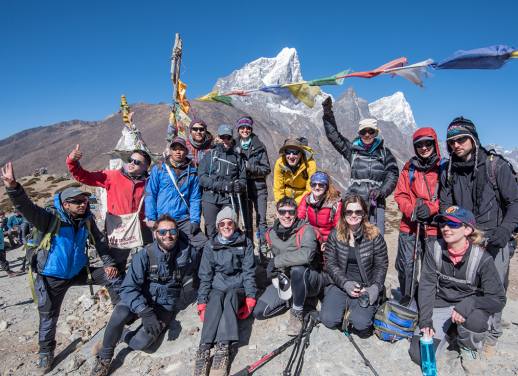
James Shackell
I was born in 1987 and aged from there. I like the sound of pop-rocks and dislike the sound of styrofoam. The length of my forearm is approximately the same as the length of my shin. My favourite Beatle is Ringo. I believe that junk food tastes so good because it’s bad for you and that your parents did the best job they knew how to do. If Johnny Cash wrote a song about my travels it would be called ‘I’ve been to several places but still have many other destinations on my to-do list, man’. Sometimes I have trouble finishing sen
You might also like
The 7 best places to go on a..., 5 reasons to visit sri lanka in the..., why 2024 is the best year to see..., yellowstone vs yosemite: which national park to visit, 6 unique experiences you can have in el..., from delhi to udaipur, here are the five..., cinque terre vs amalfi coast: which destination to..., love at first bite: 10 famous sandwiches from..., galapagos or madagascar which unique destination should be..., central vs south america: how to plan your..., 4 reasons you should take a road trip....
Discover story-worthy travel moments
Where to next.
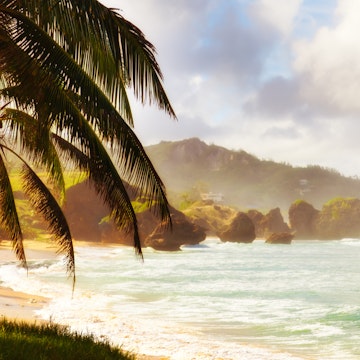
Best in travel 2024
Travel stories and news, explore our latest stories.

Food and Drink
Apr 24, 2024 • 5 min read
Eating is a national obsession in Singapore. Here are the best places to eat and drink according to a local.

Apr 24, 2024 • 10 min read
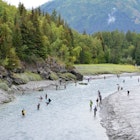
Apr 24, 2024 • 7 min read

Apr 24, 2024 • 9 min read
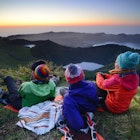
Apr 24, 2024 • 11 min read
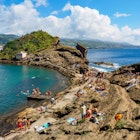
Apr 23, 2024 • 9 min read

Apr 23, 2024 • 6 min read

Apr 23, 2024 • 8 min read

Apr 23, 2024 • 5 min read

shop our books
Our guidebooks & travel books
Whether you’re interested in traveling to a new city, going on a cruise, or cooking a new dish — we’re committed to inspiring you to experience travel in a whole new way. Lonely Planet’s collection of 825+ travel and guidebooks is sure to inspire the traveler within.
#lonelyplanet
Follow lonely planet:.

Forbes Travel Guide Stories
Five Top Luxury Bike Outfitters By Forbes Travel Guide Editor Hayley Bosch
May 22, 2012
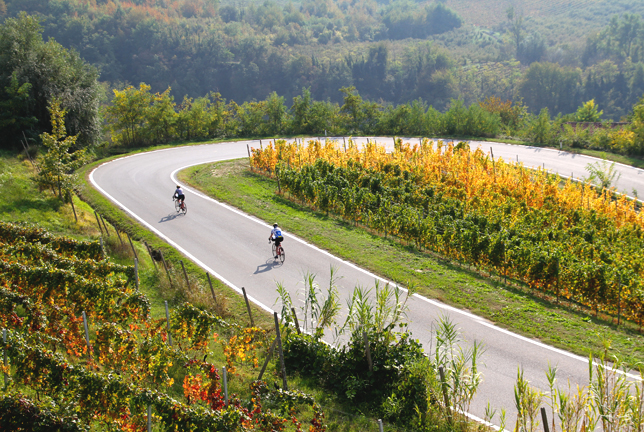
Love the idea of a cycling vacation, but prefer to end your day tucked in at a luxury inn rather than rouging it? Consider booking a tour with one of the outfitters on Forbes Travel Guide’s editors’ list of the world’s top bike companies. These tour operators provide everything from the most cutting edge bikes and gear, to exclusive tours of the top local sights, and rooms and meals at the area’s best locations. Here are our favorite luxury bike outfitters and a few their best trips.
Embarking on a multi-day biking trip is taxing, but with a little help from Backroads’ 4,000-bike inventory, things are a little easier. Top-notch bikes paired with premier inns to rest your head come nightfall make for a fantastic adventure. Like many outfitters, Backroads offers more than just biking, including hiking, kayaking and rafting, but our Forbes Travel Guide editors love the cycling trips. The guides are experienced — and local when possible — and make your tour as memorable as possible. Each day presents a variety of rides that range from easy to challenging, so you can tailor the trip to fit your level. Backroads provides everything from detailed maps for your daily spins and gourmet picnic lunches to custom-build bikes for your kids and side activities on every trip. You can go on family adventures, join a small group or book your own private tour.
Book this trip: Biking through Santa Fe and Taos with Backroads leads you into a new world of cycling and the Southwest. As one of the outfitter’s “premier inn” trips, you’ll check in to luxurious accommodations such as The Inn of the Five Graces and Rancho de San Juan, both of which exude New Mexico charm. Spinning past scenes from Georgia O’Keeffe’s paintings at Ghost Ranch and climbing through mountain villages like Las Trampas make this adventure both scenic and intriguing. Throughout your daily rides, you can take a break from the bike and stroll through places like the Taos Pueblo, where full-time residents live without running water and electricity.
Butterfield & Robinson
With tours in some of the most incredible destinations in the world (from Italy’s Piedmont region to British Columbia ), luxurious hotels and top-notch equipment, Canadian outfitter Butterfield & Robinson has long been considered one of the best in the business. Rides are as difficult as you make them — the knowledgeable guides are flexible with the activity levels and even offer optional extensions to any daily ride. Add to the mix the fact that you’re staying in top-notch hotels (some are Relais & Chateaux members, while others are luxury chains such as Fairmont and Banyan Tree) and outfitted with a state-of-the-art bike (depending on your destination, it could be a Cannondale, Rocky Mountain or Pinarello), and you’ve got yourself one of the best biking outfitters in the world. It doesn’t hurt that Toronto-based Butterfield & Robinson has been organizing trips since 1966, nurturing close ties with locals and offering memorable experiences ranging from cooking classes to truffle hunting.
Book this trip: Foodies should pencil in this fall’s Piemonte Biking tours now — you’ll spin through the rolling hills of Italy’s beautiful Piedmont region, which many believe churns out the best food in the country. For six days and five nights, the medieval towns and endless vineyards are yours to explore (including truffle hunting in Alba and a hands-on cooking lesson in Tigliole). Spending your nights in authentically Italian accommodations like Villa Tiboldi in Canale set in the middle of the Trinità vineyards and Il Boscareto Resort and Spa in Serralunga d’Alba, you can’t help but fall in love with the lifestyle. Or if you want something more far-flung, ride along one of the world’s earliest commercial highways from Xi’an to Beijing on the beautiful Silk Road, which once linked the Roman Empire and Imperial China. You’ll stay in luxurious hotels like Raffles Beijing Hotel and see remarkable sites such as the caves of Mogao.
Ciclismo Classico
Getting to know a destination is one thing, but pedaling through it with experienced guides who know the place inside and out is another. Massachusetts-based Ciclismo Classico has been biking throughout the world since 1988, providing everything from cycling clinics and a Ciclismo jersey to wine tastings and gourmet meals. Aside from learning to ride through some of the most beautiful places in the world (think Chile, the Berkshires and Sicily), the trips are designed to give you a taste of the local culture through add-ons like museums and cider tastings. While the rides are geared toward specific levels, you can adjust your day to fit your needs, or tack on an extra loop. Along with daily cycling, Ciclismo Classico offers lessons on the culture and history from the local guides, no matter where your ride may bring you.
Book this trip: Ride through the undiscovered countryside of Normandy, where you’ll stop off to taste cider, cheese and calvados. Ciclismo Classico’s Normandy tour winds you through historic sites such as William the Conqueror’s Caen and scenes straight out of paintings by Claude Monet and Eugène Boudin. At night, after your 30-mile bike ride, you’ll rest your head at charming hotels like Château Les Bruyères in Cambremer and Hotel Ivan Vautiers in Caen. Add on to your already spectacular trip by spending a few days in Brittany, strolling through majestic Mont Saint Michel and riding along the Rance River. For a trip a little closer to home — for you and Ciclismo Classico — book a ride through the Berkshires. The Western Massachusetts mountain range is filled with climbs, but you’ll be rewarded with cultural indulgences such as the Norman Rockwell Museum and Tanglewood Music Center (the Boston Symphony Orchestra’s summer home).
Trek Travel
As a world-class bike manufacturer, all of the tours Trek Travel offers are top-notch. With trips through beautiful destinations like Prague, Mallorca and California, this outfitter does it right with top-of-the-line bikes, exclusive activities and great hotels. No matter which adventure you choose, you’ll be riding one of the best bikes in the world (like the Trek Madone 5.2 and Trek 7.7 FX). Aside from the technical specs, Trek Travel takes care of everything from bike computers to gratuities. If you can’t decide which tour is for you, a dedicated trip consultant will help you make the difficult choice and answer all of your questions. And while cycling is a large part of the experience, you’ll also get a taste of the local culture through activities such as visits to archeological sites and wine tastings.
Book this trip: To celebrate Trek Travel’s 10th anniversary, the luxury outfitter is offering a special edition trip through the California Wine Country . Biking through the rolling vineyards and the jaw-dropping Redwood Forest is enough to earn that glass of wine at one of the various wineries that you’ll stop at during your rides. From an exclusive tour of Benziger Family Winery’s underground estate caves to a private winetasting at Cakebread Cellars, Trek Travel makes sure you get the most of your California biking experience. Come nightfall, you’ll rest your head at charming hotels like the Vintage Inn and Hotel Healdsburg.
DuVine Adventures
DuVine’s experienced guides paired with top-notch lodgings create a divine biking experience. With trips ranging from Israel and Spain to Ecuador and the Galapagos, there’s a tour for every palate. DuVine Adventures rates its trips based on activity level, and you can even customize your own adventure. This luxury outfitter has you covered by lining up gourmet dinners complete with wine,and upscale accommodations, and will do everything from translating the menus to choosing souvenirs. If you’re not an avid cyclist, the DuVine guides are at your side (with a support van) to make sure things run smoothly. Throughout the years, the guides have nurtured relationships with the locals, giving you that extra look into the culture with authentic cuisine and exclusive educational and cultural visits each day — think wine tastings and medieval villages.
Book this trip: You may recognize the route from Emilio Estevez’s The Way ; but Spain’s Camino de Santiago (St. James’ Way) has been a road full of pilgrims — both on bike and foot — making their way to Santiago de Compostela, where tradition has it that the remains of the apostle Saint James are buried. You’ll stop off in tiny villages along the route and rest your legs at historic hotels such as Parador San Marcos, which was once a monastery founded to house pilgrims traveling the road. After climbing hill after hill, you’re rewarded with delicious food and even better wine. Or you can discover picturesque Cape Cod , Nantucket and Martha’s Vineyard and learn about the rich history of whaling and fishing. Rest your legs at classic inns such as Hob Knob Hotel and indulge in “après velo” cocktails to reward yourself for a hard day’s work.
Photo courtesy of Butterfield & Robinson

Dreaming of your next trip?
I agree to the Forbes Travel Guide Privacy Policy and Terms . I understand I can withdraw my consent at any time.
Sign up for our newsletter

Trek Travel
Global operator
Service level
Travelers age
Trip prices
$4,299 — 5,499
Tour languages
Quick Links:
Trips other travelers liked

Northern Lights Escape

“Where the mountains meet the sea”- Kotor Bay, Lovcen & Skadar Lake National Park
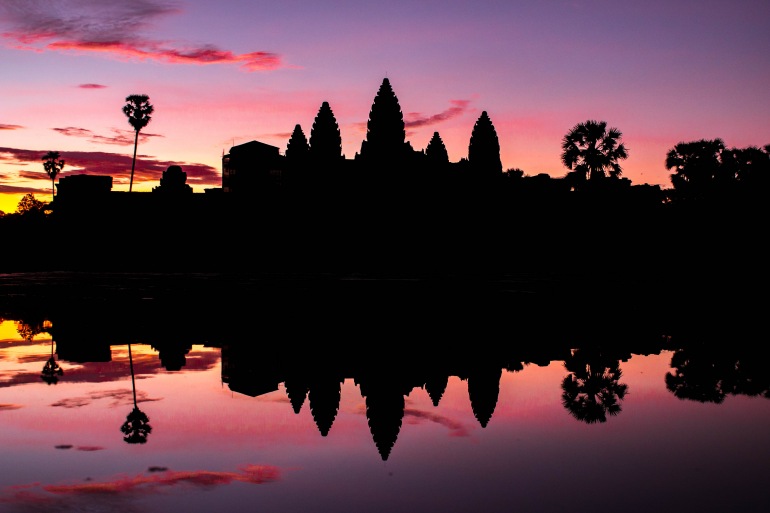
Family Fun In Cambodia

Iceland Discovery
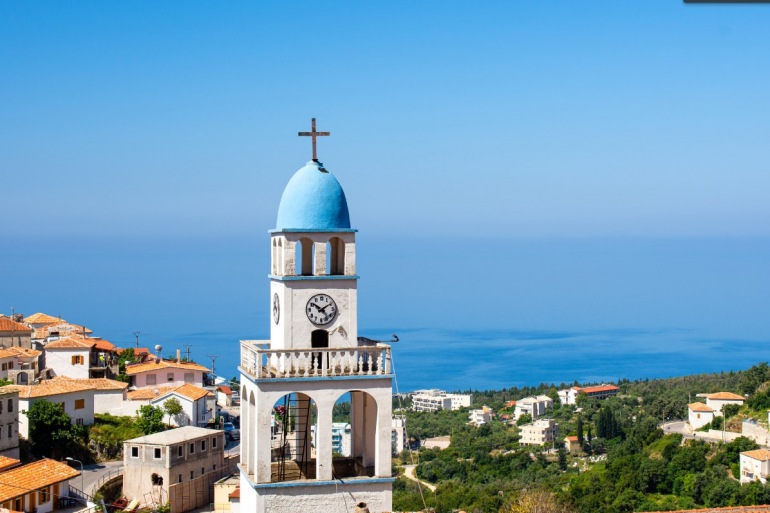
Discover Albania

Ice to Sun 2023: Argentina & Brazil

4-Days Cuyabeno

Brazil (North): See & Experience it ALL in 13 Days, 1st Class Custom Tours
Member savings.
Sign in to see which companies give additional savings to Travelstride Members (it’s free)
- Group Tours
- Private Guided Trips
- North America
- South America
Compare with Trek Travel
View all tour company comparisons
How well do you know the world?
Trek travel reviews & ratings, no regard for safety.
Trek Travel has just removed mask requirement for their trips. Number of COVID cases are steadily increasing in the past weeks. This is irresponsible and dangerous a...
Professional freelancer trek guide
Professional freelancer trek/tour/birding guide in Pokhara, Nepal
Hi Namaste , All of Travelers in Nepal, I am Professional freelancer (Independent) Trekking Guide Tulasi Ram Paudel in the Nepal,Grade “A” license holder from Minis...
Haresh Patel
Best trekking guide from Pokhara Nepal
Yes, we went for trek for 4 days only and total Nepal trip was for 8 days. He didn't just limited his guidance to trek only. He was go to person for us for each and ...

Disturbing Coronavirus Management
My parents booked a Trek trip in Italy this spring. We're very disappointed that with the coronavirus escalating in Italy, we cannot attend. When we called Trek to c...
Best trips I have ever done, did the Rhine River Cruise and Trek Travel was the ...
See all Trek Travel reviews

Editoral Review of Trek Travel
Founded in 2003, Trek Travel is a great option for hobby cyclists as well as die-hards. Their trips are specifically designed to cater to multiple types of traveler.
What Makes Trek Travel Stand Out?
- Large selection of tours
- Large selection of high quality bikes
- Multiple daily ride options
- Minimum of two Trek Travel guides per tour
Part of their mission is to “make adventure accessible” and they pride themselves on helping bikers and travelers see the world in comfort and fun.

Who Will Enjoy Traveling with Trek Travel?
- Ages 6+ on family trips
- All cycling skill levels
- Lovers of the great outdoors
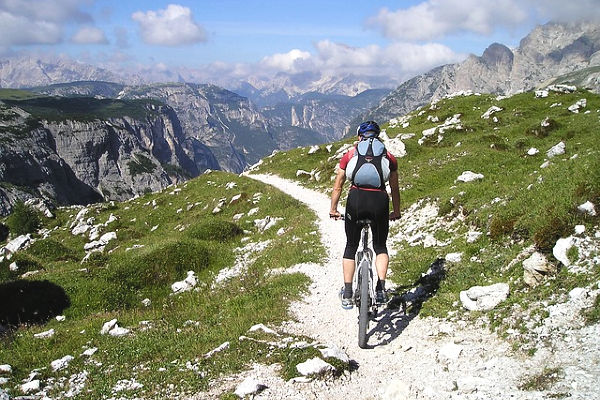
They cater to the individual, aiming to make everyone’s riding experience enjoyable. If you only feel like riding half a day, and spending the rest relaxing, they can accommodate!
There are two levels of pricing to accommodate for varying budgets. Since they attract a wide range of customers, you’ll be sure to find yourself in a dynamic and fun group of people. You’ll meet people from all over the world that share an interest in biking and travel.
Top Destinations
- Latin America
- Asia Pacific

Their trips often take place off the beaten path. So not only will you find yourself in the midst of untouched countrysides and mountainscapes, but you’ll discover hidden gems along the way.
Casually ride through the picturesque town of Grazalema and try some local cabernet on a Trek Travel Spain tour. Or challenge yourself to climb legendary alps, such as Alpe d’Huez and Galibier on one of Trek Travel’s tours in France.
Trek Travel Style
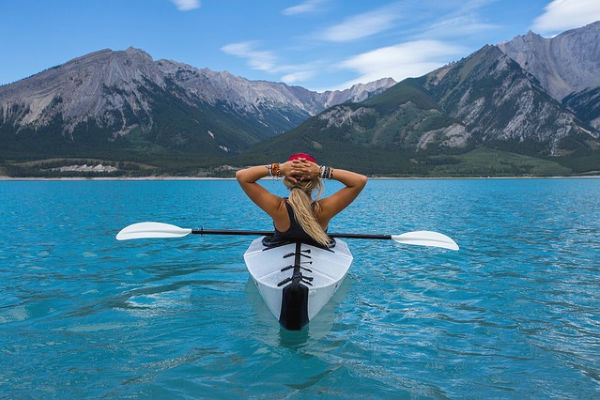
Although they are known for biking, they offer so much more than just a cycling vacation. Itineraries offer plenty of activity options every day if you want to have a day off your bike. Cultural and culinary related activities are offered such as wine tasting, pizza making, and historic walking tours. If you enjoy being active, choose from activities like sailing and kayaking.
All breakfasts are included so you’ll have the energy needed to cycle all day. After a long day of riding you are treated to cocktails, dinner, and comfortable accommodation.
Accommodations are categorized either by explorer or luxury. With explorer, you’ll be placed in casual 3-star boutique hotels. The amenities may be simple, but you’ll still get incredible views, delicious cuisine, and the utmost relaxation.
If you prefer the luxury option, expect handpicked 4-star accommodations that include signature spa treatments and Michelin-starred restaurants. Imagine resting in a historic hotel nestled deep in the woods of the Tramuntana Mountains on a tour to Spain with Trek Travel.

Every tour with Trek Travel is categorized by different “rider types”:
Leisure: You are relatively fit but don’t want to ride everyday of your vacation. You’d like to balance cycling with exploration and relaxation time. Expect slight inclines and roughly 1-2 hours of riding.
Recreational : You bike on a somewhat regular basis - maybe to work, for fun on the weekends, or for fitness. Expect steep rollers and short mountains. You’ll ride for roughly 2-3 hours per day.
Active : You bike regularly for a few hours on a weekly basis. If fitness is a big part of your life and you like a good challenge, you’ll fit right into the active level tours. You’ll climb hills, mountains, and everything in between for 3-4 hours per day.
Avid : You ride 100 miles per week and enjoy riding at a fast pace for long hours. Perhaps you regularly train or race. If you believe no road is too steep, and no route is too long, then these trips are made for you.
Why Choose a Tour with Trek Travel?
- Guaranteed dates and trip prices *for most trips - some special trips need more people to run
- Offline gps map, itinerary, and guide and hotel contacts on your phone
- Partnership with Trek bike store
What you want to get out of the vacation, they strive to provide. Every day you can choose how far you want to ride, and what activities you’d like to partake in. The Trek Travel guides have extensive experience and knowledge, both in bike maintenance and leading tours. Trek Travel provides the perfect combination of luxury and activity, as you make the trip your own.
Unlock Community Benefits
Travel better together.
- Save favorite trips and itineraries
- Get insider insights
- Receive personalized recommendations
- ... and much more
More Details
Solo friendly.
- No single supplement
Travelstride featured in
About the company.
You’ll know our difference the minute you say our name.
We’re born from Trek bikes, and that means everything that makes Trek great is in our genes, too. Like the passion to be the best. To make adventure accessible. And to do things right, in the right way. We’re a team of globetrotters, world-travelers and dreamers who know how to inspire the memories you’ll have for the rest of your life. It’s our job to find the best roads, hotels, towns, food, routes and attractions and introduce them to you. All on bikes that you’re guaranteed to love.
Exceptional Guides.
They aren’t just experts in riding; they’re trained in delivering uncompromising service in ways you won’t believe.
The Best Bikes.
Trek is in our name. Bikes are in our blood. Part of what makes a bike vacation great is the bike you’re riding.
More is Included.
Little things make a big difference. We look for ways to include more into every trip, so you can get more out of it.
Guaranteed to Run.
As long as you’re going, we’re going. We’re travelers too, and we realize that your vacation schedule isn’t flexible. We won’t cancel a guaranteed trip on you.
Wow Moments.
WOW is in our DNA. Is there any other tour operator who evaluates itself on its ability to wow its guests?
nrivaled Support.
Throughout the day our guides give unrivaled support ensuring every rider gets the personal attention they deserve.
Your Day, You Decide.
It’s your vacation, after all. Here, you choose the ride you want to do from three daily options and you decide how you want to spend your day.
Expert Design.
The perfect trip is like a play. Every hotel, activity, experience and aspect is finely choreographed. To us, every moment matters.
Built for Every Rider.
Our guests all share one thing in common: they believe that seeing the world by bike is better. We make sure to have the perfect biking trip for any riding level.
Loyalty Club.
After just one trip with us, we welcome you to the Club. Club TT gets you access to added extras, savings, bonuses, and more.
Trek Travel Trips & Specials

Cross Country USA: Portland to Missoula

Great Smoky Mountains and Blackberry Farm
Want a tailor-made trip instead, your trip, your way, planned by an expert:.
- You choose budget, destinations, activities, transport & lodging type
- Expert designs the itinerary for you, and once approved, takes care of logistics
Top Trek Travel Trip Categories
Trek travel company ranking by category, similar companies.

About Travelstride
Find your perfect trip, travel confidently.

- Humor & Entertainment

Enjoy fast, free delivery, exclusive deals, and award-winning movies & TV shows with Prime Try Prime and start saving today with fast, free delivery
Amazon Prime includes:
Fast, FREE Delivery is available to Prime members. To join, select "Try Amazon Prime and start saving today with Fast, FREE Delivery" below the Add to Cart button.
- Cardmembers earn 5% Back at Amazon.com with a Prime Credit Card.
- Unlimited Free Two-Day Delivery
- Streaming of thousands of movies and TV shows with limited ads on Prime Video.
- A Kindle book to borrow for free each month - with no due dates
- Listen to over 2 million songs and hundreds of playlists
- Unlimited photo storage with anywhere access
Important: Your credit card will NOT be charged when you start your free trial or if you cancel during the trial period. If you're happy with Amazon Prime, do nothing. At the end of the free trial, your membership will automatically upgrade to a monthly membership.
Buy new: $12.95 $12.95 FREE delivery: Wednesday, May 1 on orders over $35.00 shipped by Amazon. Ships from: Amazon Sold by: Big Ben's Mall
Return this item for free.
Free returns are available for the shipping address you chose. You can return the item for any reason in new and unused condition: no shipping charges
- Go to your orders and start the return
- Select the return method
Buy used: $6.47
Fulfillment by Amazon (FBA) is a service we offer sellers that lets them store their products in Amazon's fulfillment centers, and we directly pack, ship, and provide customer service for these products. Something we hope you'll especially enjoy: FBA items qualify for FREE Shipping and Amazon Prime.
If you're a seller, Fulfillment by Amazon can help you grow your business. Learn more about the program.

Download the free Kindle app and start reading Kindle books instantly on your smartphone, tablet, or computer - no Kindle device required .
Read instantly on your browser with Kindle for Web.
Using your mobile phone camera - scan the code below and download the Kindle app.

Image Unavailable

- To view this video download Flash Player
Follow the authors

Hidden Universe Travel Guides: Star Trek: Vulcan (1) Paperback – July 19, 2016
Purchase options and add-ons.
- Print length 160 pages
- Language English
- Publisher Insight Editions
- Publication date July 19, 2016
- Dimensions 6 x 0.6 x 9 inches
- ISBN-10 1608875202
- ISBN-13 978-1608875207
- See all details

Frequently bought together

Similar items that may ship from close to you

Editorial Reviews
About the author, product details.
- Publisher : Insight Editions (July 19, 2016)
- Language : English
- Paperback : 160 pages
- ISBN-10 : 1608875202
- ISBN-13 : 978-1608875207
- Item Weight : 13.4 ounces
- Dimensions : 6 x 0.6 x 9 inches
- #485 in Science Fiction & Fantasy Movies
- #2,864 in TV, Movie & Game Tie-In Fiction
- #13,183 in Science Fiction Adventures
Videos for this product

Click to play video

Hidden Universe Travel Guides: Star Trek: Vulcan
Publisher Video
About the authors
Dayton ward.
If you’re reading this, then chances are you’ve read one of my books or are considering doing so. Or, maybe you just clicked on a link by mistake while on your way to something more interesting.
Doesn’t matter. Welcome!
So…about me. Yeah…well, you see, it’s like this: Until recently, I was a software developer and analyst, having become a slave to Corporate America after spending eleven years in the U.S. Marine Corps. Why did I join the military? Pretty simple, really. I’d gotten tired of people telling me what to do all the time, and was looking for a change.
In truth, I joined for a handful of different reasons, from carrying on a family tradition to wanting a challenge unlike anything else I’d faced to that point to simpler stuff like just wanting to see the world. I’m proud of my time spent in uniform. I gave Uncle Sam eleven years, and he gave me a long list of skills and experiences that have continued to serve me to this day. I think I got the better end of that deal by a fairly wide margin.
In September 2014, I said goodbye to my day job and embarked on a bold new journey as a full-time writer.
Though I was born and raised in Tampa, Florida, fate and circumstances have seen to it that my family and I now call Kansas City home.
Livio Ramondelli
Livio Ramondelli is an illustrator with credits including Transformers for IDW Publishing, Star Trek Hidden Universe: Vulcan and Klingon Empire for Insight Editions, as well as covers for BOOM! Studios, Dynamite and Legendary Comics. He has also provided storyboards and concept art for Niantic, Universal Studios Japan, Google and Hasbro. He previously worked as a concept artist for DC Universe Online for Sony/DC Comics. He is also known for creating, writing and illustrating The Kill Lock, an original science fiction comic book series, for IDW Publishing.
Customer reviews
Customer Reviews, including Product Star Ratings help customers to learn more about the product and decide whether it is the right product for them.
To calculate the overall star rating and percentage breakdown by star, we don’t use a simple average. Instead, our system considers things like how recent a review is and if the reviewer bought the item on Amazon. It also analyzed reviews to verify trustworthiness.
Reviews with images

- Sort reviews by Top reviews Most recent Top reviews
Top reviews from the United States
There was a problem filtering reviews right now. please try again later..

Top reviews from other countries
- Amazon Newsletter
- About Amazon
- Accessibility
- Sustainability
- Press Center
- Investor Relations
- Amazon Devices
- Amazon Science
- Sell on Amazon
- Sell apps on Amazon
- Supply to Amazon
- Protect & Build Your Brand
- Become an Affiliate
- Become a Delivery Driver
- Start a Package Delivery Business
- Advertise Your Products
- Self-Publish with Us
- Become an Amazon Hub Partner
- › See More Ways to Make Money
- Amazon Visa
- Amazon Store Card
- Amazon Secured Card
- Amazon Business Card
- Shop with Points
- Credit Card Marketplace
- Reload Your Balance
- Amazon Currency Converter
- Your Account
- Your Orders
- Shipping Rates & Policies
- Amazon Prime
- Returns & Replacements
- Manage Your Content and Devices
- Recalls and Product Safety Alerts
- Conditions of Use
- Privacy Notice
- Consumer Health Data Privacy Disclosure
- Your Ads Privacy Choices
- More to Explore
- Series & Movies
Published Jan 23, 2016
FIRST LOOK: Hidden Universe: Star Trek: A Travel Guide to Vulcan
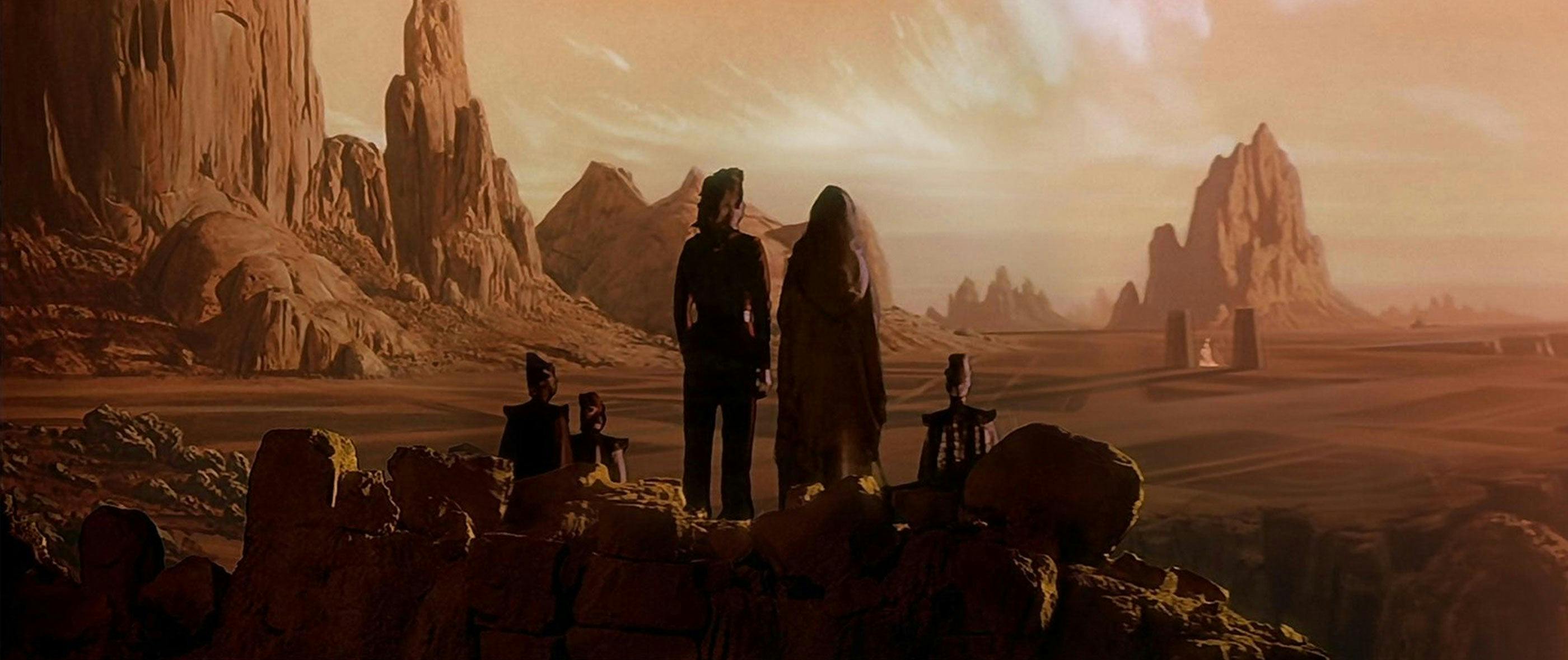
Dayton Ward is boldly going in a new direction. Ward, the author behind many, many Star Trek novels -- including Elusive Salvation, Armageddon's Arrow, Point of Divergence, Peaceable Kingdoms, That Which Survives, Summon the Thunder, From History's Shadow, Turn the Page and the recent All That's Left -- will return this summer with Hidden Universe: Star Trek: A Travel Guide to Vulcan . It's an interactive guidebook that explores everything Spock's home planet has to offer.

Here's the synopsis, straight from the publisher, Insight Editions: Plan your next trip to the planet Vulcan with Hidden Universe: Star Trek: A Travel Guide to Vulcan ! Find restaurants that serve the best fried sandworms and Vulcan port. Take a trip to the Fire Plains or experience spring break at the Voroth Sea. Learn all about the native Vulcan people and their unusual customs. Discover how to correctly perform the traditional Vulcan salutation (you really don’t want to get this wrong). Learn key Vulcan phrases such as Nam-tor puyan-tvi-shal wilat: “Where is your restroom?” Find out what to do if you suddenly find yourself host to a katra—a Vulcan’s living spirit—at an inconvenient moment. All this and more can be found within the pages of this essential travel guide to one of the most popular—and logical—destinations in the known universe. Hidden Universe: Star Trek: A Travel Guide to Vulcan draws on 50 years of Star Trek TV shows, films, and novels to present a comprehensive guide to Spock’s iconic home world. Modeled after real-world travel guides, the book will explore every significant region on Vulcan with fascinating historical, geographical, and cultural insights that bring the planet to life like never before. Also featuring a dynamic mixture of classic Star Trek imagery and original illustrations created exclusively for the book, Hidden Universe: Star Trek: A Travel Guide to Vulcan is the perfect way to celebrate 50 years of Star Trek and will thrill pop culture fans and hardcore Star Trek fans alike. Due out on July 19, Hidden Universe: Star Trek: A Travel Guide to Vulcan will be released as a paperback that measures 6 x 9 inches and runs 160 pages. It will cost $19.99. Go to www.amazon.com to preorder it.
Get Updates By Email
From your first mile off pavement to your five-hundredth, gravel riding ignites something inside us that’s hard to tap into anywhere else. Whether you’re pursuing quiet miles away from town, far-off scenic horizons filled with laughter and friends, a new physical challenge, or something else entirely, we’ve got you covered with all the knowledge, bikes, and gravel gear you need to explore what’s waiting for you down the road less traveled.
- Your intro to gravel biking
- Gravel bikes and gear
- Gravel riding resources
Gravel riding is a versatile style of cycling that fits neatly between road and mountain biking. It takes you off the beaten path over miles of multi-surface, unpaved, and rough roads. While it’s referred to as gravel riding, you’ll find that sturdy gravel steeds are eager to explore everything from dusty rail trails to steep and rocky fire roads — or even on wooded singletrack, if you dare.
What is a gravel bike anyway? Gravel bikes are multi-surface bicycles built to explore the millions of miles of unpaved roads that roll on long after the pavement ends. They find the balance between the off-road capability of a mountain bike and the quick-rolling, lightweight feel of a road bike, giving you every benefit you need to explore far beyond the pavement.
Anatomy of a gravel bike
1. Long, stable geometry
Gravel bikes typically feature a longer wheelbase that helps elevate stability in rough terrain, and a slightly more open cockpit to boost comfort on long rides.
2. Tire clearance
To give you a boost of traction and comfort, gravel bikes typically offer more clearance for higher-volume (38mm - 45mm), knobbier tires than those used for road bikes.
3. Mounts for bags & cages
Gravel rides can take you far away from resources like water, bike shops, and even cell service, so many gravel bikes come with mounts for cages, racks, and bags that let you load up with all the essentials you might need for the long-haul. Some even feature internal frame storage for stashing tools and gear!
Gravel bikes vs road bikes Find out what sets them apart.
- Watch the video
Types of gravel surfaces
A little bit of everything. Smooth tarmac, rough pavement, rugged cobbles, and light gravel. Bikes for all-road riding should accept tires 32 - 38c wide.
- Shop all-road bikes
Roads and paths with mixed surfaces ranging from hard-packed dirt to deep, loose gravel, and dusty, rocky terrain. Gravel riding is best done with tires 35 - 45c wide.
- Shop dedicated gravel bikes
Bikes made for the kind of gravel you’re chasing No matter the kind of gravel surface you ride or the goals you’re chasing, we've got you covered with gravel bikes for every kind of gravel riding and terrain.
Ready for the rougher stuff? Pure gravel riding involves minimal time on pavement and maximum time on gravel, dirt roads and light singletrack. Bikes that are purpose-built for gravel prioritize stable geometry, tire clearance, comfort, and mounts for gear.
Checkpoint is the ultimate drop bar gravel bike for big adventures, gravel racing, and bikepacking. –Up to 45mm (2.1in) tire clearance –Progressive geometry that balances quick handling with comfort –Flared gravel handlebar for comfort on the long haul –Tons of mounts for bags and racks
All-road riding lets you choose your adventure. Bikes built for all-road offer a handful of benefits both from gravel and road bikes, like extra tire clearance and a lightweight build that gives you versatility wherever you ride.
Domane is a drop bar all-road bike built for mixed-surface rides that roll anywhere from ancient cobbles to crushed gravel. –Up to 38mm tire clearance –Comfortable endurance geometry for all-day rides
FX Sport is a flat bar all-road bike perfect for riding pavement and gravel paths, or even light touring. –Up to 40mm tire clearance –Upright, comfort-focused riding position –Mounts for bags and a rack
Want to explore what’s beyond the pavement with a little boost? Electric gravel bikes give you all the capability and versatility of a traditional gravel bike, plus welcome support that keeps you feeling fresh through long offroad miles and up steep, winding climbs.
Get all-road and gravel capability with an electric boost on Domane+. These drop-bar electric bikes help you ride farther and faster wherever you roam. –Models range from 38mm all-road to 40mm gravel tire clearance –Support for speeds of 20 or 28mph, depending on model
Go beyond the road and onto muddy CX courses, grassy hills, sand pits, and winding trails. Cyclocross bikes are made for racing, with aggressive geometry that keeps you in a powerful riding position and clearance for knobby tires that bite into mud and dirt.
Boone is a lightweight carbon cyclocross race machine for hopping hurdles and ripping through grass, mud, and sand. –Up to 38mm tire clearance –Cross-specific geometry and vibration-damping tech for power, control, and comfort.
What size gravel bike do I need? The perfect bike fit will keep you cruising through the choppy stuff with composure and comfort. Find out what size bike is the best fit for you with our bike size finder.
- Find your bike size
When you’re saddled up on a go-anywhere, do-anything gravel bike, you need gear that’s made to handle it all. Browse our selection of gravel bike equipment to find everything you need, like compact multi-tools that fit in your back pocket, helmets and shoes to keep you covered from head to toe, and bar tape to soak up the chatter from rough roads and keep you feeling fresh all day.
- shop all gravel gear
Adventure bags
Bike bags should have all the capability and gear storage you need to get outside — and stay there. Whether you are gravel riding, bikepacking, touring, or anything in between, Adventure Bags are ready to load up with rugged, waterproof protection for your gear, and clever mounting systems that can even bolt directly to some Trek models, like Checkpoint.
What kind of tires do I need?
Tires are a surprisingly personal choice for your bike and picking the right ones will help you have the most fun on every gravel ride. From puncture protection to grip and size, many factors play a role in your perfect tire choice. A good rule to start with is, the rougher the gravel, the bigger the tire you want – just make sure they fit your wheels and bike.
- See the tire finder
- Learn about gravel tires
Whether you’re just getting started riding off-road, ready to sign up for your first gravel race, or looking for tips on how to load up for gravel bikepacking adventures, we’ve got you covered. Explore our tips, tricks, and guides for the best gravel rides.
- Learn how to ride gravel
Beginner’s guide to racing gravel
Gravel tips from the pros .
- See the tips
- Follow the pros
How to bikepack on a budget
Where can I ride gravel? There are over a million miles of unpaved roads across the United States alone. Find out where you can find the best gravel rides near you, or incredible rides you can explore on your next gravel getaway. Adventure is waiting for you.
- Explore Great Rides
- Explore Gravelmap.com
Gravel bikepacking & touring
Got an unquenchable thirst for adventure? Bikepacking and touring is your answer. Ride far beyond the beaten path and camp under the stars on bikes built to load up and roll way, way out there.
Still need help finding the perfect bike?
We've got the tools to help you find the right bike for you.
Gravel, grit, and fresh paint
Make your gravel bike build exclusively yours with custom paint and your favorite components with Project One.
Talk to the experts in gravel
Want to get tips or talk through your next adventure? Stop by your local Trek store to chat with the experts.

- Best Hikes In The World
- Appalachian Trail
- European Hikes
- Nepal Hikes
- Patagonia Hikes
- See All Hikes
- Mount Kenya
- Mount Kilimanjaro
- Mount Toubkal
- See All Mountains
- South Africa
- New Zealand
- Switzerland
- United Kingdom
- Packing Lists
Cordillera Huayhuash – Epic South American Circuit Trek (Travel Guide)
The Cordillera Huayhuash Circuit is known to be one of the most challenging and most beautiful treks in South America .
This guide will help you plan your Huayhuash trek, whether you’re going independently or with an experienced guide or trek operator.
Cordillera Huayhuash Circuit Overview
The Cordillera Huayhuash Circuit is a 68 mile / 110km trek through a remote region of the Peruvian Andes . Elevations on this trail reach upwards of 16,600 feet/ 5,060m.
The region was made famous by the tragic mountaineering book (and film) Touching the Void . It is a survival story of a climber who falls into a crevasse after his partner is forced to cut the rope, then has to save himself. Don’t worry though. There is no mountaineering involved on the trail.
The appeal of the Cordillera Huayhuash Circuit is in the scenery. This region is brimming with turquoise alpine lakes, craggy snow-covered peaks, open green fields, misshapen multi-colored mountainsides, and fire-hued sunsets.
It takes anywhere from 7-14 days to complete the Huayhuash circuit, with 10 days being the average pace. There is only one village where you can resupply along the way. Otherwise, it’s entirely a wilderness experience. Be fully equipped with all the gear you need to sleep, cook, and stay warm and dry in the mountains.
The Cordillera Huayhuash region is not nearly as popular of a destination as it’s Cordillera Blanca counterpart. While you will likely see a few other groups every day, it is certainly not a busy destination.
If doing this trek independently, you will arrive via public transportation to Pocpa. From there it takes a few hours to walk to the start of the trail. Alternatively, you could arrange transport with a trekking agency.
It is better to bring backpacking snacks from home for the trek, as the options at the grocery store are limited. If you’re on an extended trip and not beginning from home, perhaps you could do your food shopping in Lima.
There are no permits required for the Cordillera Huayhuash Circuit. However, there are nine different communities charging fees for land use. The total price for all the fees adds up to about 205 soles ($62).
Cordillera Huayhuash Trek Facts
- The distance of this trek is 68 miles / 110km and takes 7-14 days to complete. Most people hike in a clockwise route.
- The maximum altitude on the circuit is 16,600 feet/ 5,060m. There is a total of 18,700 feet/ 5,700m of vertical uphill walking.
- Difficulty is strenuous. It’s a high-altitude, wilderness hike with drastic elevation changes.
- Best months to hike the Huayhuash circuit are May- September.
- Guides are not mandatory, but are recommended for inexperienced trekkers.
- No permits required. There are campsite and land use fees that amount to a total of 205 soles/ $62.
What to expect while trekking the Cordillera Huayhuash circuit
Typical itinerary, huaraz: 2-3 nights.
The city of Huaraz sits at 10,000 feet/ 3,050m. I recommend spending several nights here in order to start acclimatizing. Take a bus out of town and do a day hike to further help with acclimatization.
Additionally, if you have any extra belongings you don’t want to take on the trek, you can store them at your hotel or hostel.
Day 1: Quartelhuain
Catch the 5 am bus from Huaraz to Chiquian. The bus company is called El Rapido . From Chiquian, take the 8 am bus to Pocpa. Once you’ve arrived in Pocpa, it takes several hours of walking along the road to reach Quartelhuian. Spend the night there.
Day 2: Mitucocha Camp
Elevation gain: 1,706 feet/ 520m
It’s a relentless climb up to Cacananpunta first thing in the morning. Then a mellow hike down to the campsite. While this is a short day, I recommend staying at Mitucocha Camp. It’s better to ease into the trek than do two big climbs on the first day in the backcountry.
Day 3: Carhuacocha
Elevation gain: 1,400 feet/ 430m
The climb up Carhuac is rewarded by views of snow-capped peaks on the descent. The campsite is beside an alpine lake and is an excellent spot to catch some sunset photos of the lake and mountains. This campsite is not very large, so expect to be in close proximity to any other trekkers.
Day 4: Huayhuash
Elevation gain: 1,300 feet/ 400m
Today is one of the most spectacular days as far as scenery goes. There are several alpine lakes that act as mirrors to the surrounding peaks.
You can even jump in one if you’re feeling bold and not afraid of the cold. Expect to hear and see giant chunks of ice breaking from the surrounding cliffs and crashing to the ground.
Day 5: Viconga
Elevation gain: 1,380 feet/ 420m
Today is just as scenic as all the rest, but perhaps the highlight of this day is the Viconga campsite. There is a hot spring for weary trekkers to soak in while enjoying the surrounding mountains. The man-made concrete tubs are filled with natural hot spring water, and it’s the perfect way to end a long day.
Day 6: Cuyoc Camp
Elevation gain: 2,330 feet/ 710m
This is the biggest elevation gain of the hike so far. However, it’s not as steep as previous climbs and you should be well acclimatized by now. Take it slow. You’ll be rewarded at the top with views of peaks and colorful mountains.
Day 7: Huatiaq
Elevation gain: 2,525 feet/ 770m; however, there will be additional elevation gain if you choose to take the scenic route in the morning
The guidebook suggests two days to reach Huatiaq from Cuyco Camp, but it is possible to do in one. This is also the day you can go to Huayllapa to resupply. You can start your morning by choosing your route: a more scenic, uphill climb. Or an easier walk down the valley if you’ve had enough of stunning mountain scenery.
There’s a small shop in Huayllapa where you can buy basic supplies. They don’t have anything too extravagant; just Ramen noodles, oatmeal packets, and packages of cookies.
After visiting the village, start the steep climb up to the campsite.
Day 8: Incahuain
Elevation gain: 2,750 feet/ 840m
This is the last full day of trekking the circuit. There are two passes today, and after you can choose to do a ridgeline walk if you want to get some bonus views. The ridgeline is not too difficult, so you might want to give it a go. Finally, after more alpine lake views, you descend down to your final campsite of the trek.
Day 9: Llamac
Elevation gain: 1,100 feet/ 340m
Set off early if you’re planning on taking public transportation back to Huaraz. The bus leaves around 11:30am. There is one final low pass to get over, then you hike down into the village of Llamac.
Things You'll Need for Your Cordillera Huayhuash Trek
Gear checklist.
- Backpack (about 50L)
- Trekking poles
- Tent (there are no trees for tying tarps or hammocks)
- Sleeping bag , around 20 F (-7C) and a sleeping pad (in case you aren't hiking with a tour operator)
- Camp stove and fuel canister, can be purchased in Huaraz
- Water bottles, capacity for 2-3L
- Water treatment method
- Navigational equipment: map, compass, guidebook, GPS or SmartPhone
- Hiking clothes
- Trail runners / hiking boots
- Rain jacket
- Down jacket / warm synthetic layer
- Long-sleeve base layer shirt
- Base layer bottoms
- Warm hat and gloves
- Sunscreen and trekking sunglasses
You're welcome to check out our multi-day hiking list for more helpful ideas on what to pack for Cordillera Huayhuash.
Recommended Guidebooks and Maps
Peru’s Cordilleras Blanca & Huayhuash: The Hiking & Biking Guide is the most comprehensive resource on the circuit.
Please Note: The latest version of this guidebook will go on sale on Amazon on 1 September 2023 . So, make sure you're first in line to buy it!
You can also download the maps.me maps of the region, since a lot of the trail is marked on the app.
If you’re trekking without a guide, we recommend buying a map at one of the trekking shops in Huaraz.
Please Note : It’s important that hikers who go without the assistance of a guide and mules are aware of what they’re getting into. This is a high-altitude trek through a remote region of the Andes with no road access. Should something go wrong, it would not be easy for help to arrive.
Hikers must be fully equipped with enough food to last until the village of Huayllapa. The threat of acute mountain sickness is real, and hikers should have an understanding of symptoms and treatment.
Furthermore, there are no trail signs and sometimes the path is not obvious. Trekkers should have a basic understanding of navigation and carry a map, compass, and GPS or SmartPhone with the regional maps downloaded for offline use.
Cordillera Huayhuash FAQs
When is the best time to hike cordillera huayhuash.
May to September are the best times to hike the Cordillera Huayhuash Circuit.
The weather is cold, but dry. Expect frost on your tent every morning and have layers accessible during the day.
The other months of the year are the wet season, and the passes will likely be difficult to cross because of snow.
What can I expect on a typical Cordillera Huayhuash trek?
There are no permits for this trek but bring enough money for the land use fees. They amount to 205 soles ($62).
Take the local buses to get to the trailhead. Arrange your ticket the day before at the El Rapido bus station in Huaraz.
The bus to Chiquian leaves at 5am, and from there you will catch a different bus to Pocpa. On the last day of your hike, catch the 11:30am bus out of Llamac.
Either bring food for the trek from home or buy it in Lima, as Huaraz does not have many good options for backpacking food.
How difficult is the Cordillera Huayhuash Circuit Trek?
The Cordillera Huayhuash Circuit is an extremely difficult trek, especially if you are planning to self-navigate and carry your own gear.
While the distances may seem small, keep in mind that it is at a high altitude with drastic elevation changes.
Furthermore, there is no easy way to get out should you experience symptoms of acute mountain sickness.
Therefore, it is crucial that you take several days to acclimatize in Huaraz and do a day hike before beginning the circuit.
Is it safe to hike the Cordillera Huayhuash Circuit alone?
In terms of is the region safe for tourists, yes, very much so. In terms of if the mountains are safe for you personally, this really depends on your experience.
Ask yourself these questions:
- Do you feel comfortable navigating your own way in the mountains?
- Have you gone on a backcountry trip of similar length before?
- Do you have experience hiking at high elevations?
If the answers are yes, then you are probably ready.
Where do I find water along the Cordillera Huayhuash Circuit?
All of the Cordillera Huayhuash campsites have water sources, and there are streams throughout the day as well. Just be sure to fill up before you start up the passes, as you might hike several hours between water sources during the day.
Is acute mountain sickness a risk with Cordillera Huayhuash?
Yes. Do proper research ahead of time on what the symptoms of mountain sickness are and be aware of how to treat it. You can read about acute mountain sickness.
Do I need travel insurance for Cordillera Huayhuash?
If you plan to hike Cordillera Huayhuash Circuit, make sure that you are adequately insured for up to 4,000m. Get a quote from World Nomads .
Do I need to know Spanish for Cordillera Huayhuash?
Not necessarily, but it is helpful if you learn a few Spanish phrases. While traveling around Peru, it will be a challenge to get around if you are only trying to speak English.
Once on the trail, you really don’t need to speak to that many people other than the locals who collect land use fees. If you don’t know Spanish, don’t let it be a deterrent to coming to Peru. Just be ready to have a tough time.
You may also like...
See our detailed guide to South American mountain ranges . Or check out our country hiking guides below.
- Best Hikes in Chile
- Best Hikes in Argentina
- Best Hikes in Ecuador
- Best Hikes in Mexico
- Quilotoa Loop Trail
- Best Hikes in South America
- Climbing Chimborazo
- Best Hikes in Patagonia
Also see our detailed Mountain Guides or explore our Hiking Tours available exclusively on Mountain IQ .
References : BBC Travel , Lonely Planet , Wikipedia
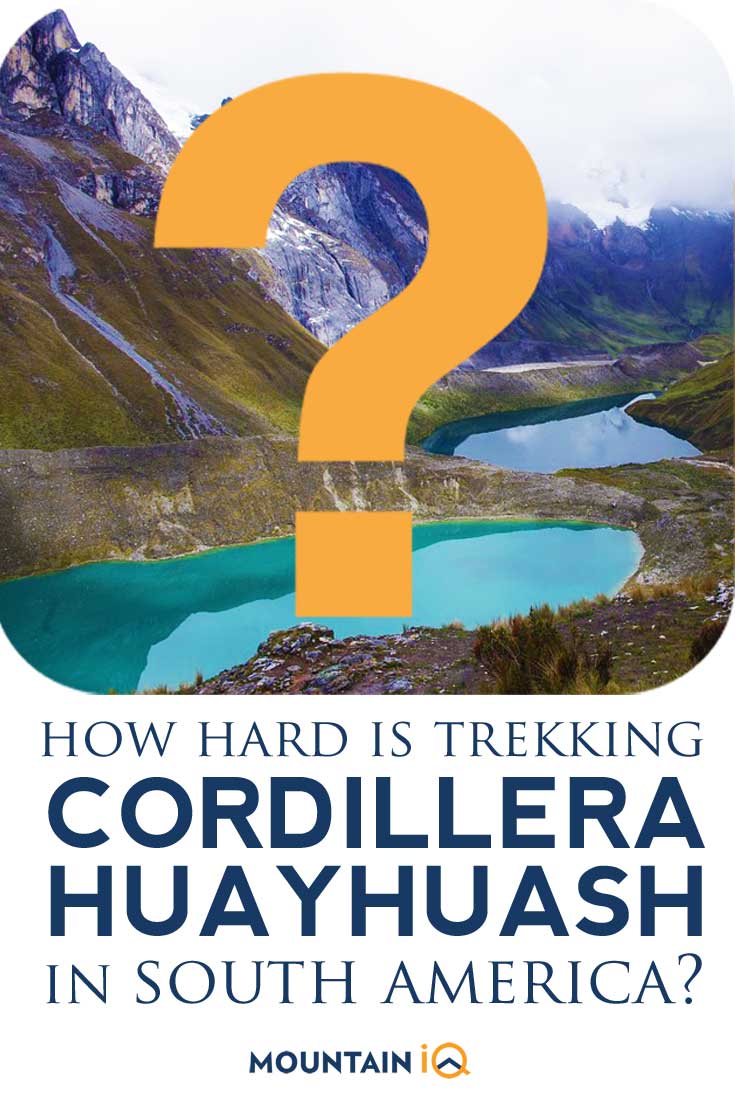
About the author
Megan Maxwell
Megan is a long-distance hiker, blogger, author, and outdoor professional. She has travelled all over the world in search of mountains and unique trails. She found her love of hiking on the Appalachian Trail back in 2012 and since then has hiked in the Himalayas, the Andes, and a few countries in Europe. On her blog, Mountains with Megan she provides information on hiking and backpacking all over the world.
Leave a Reply
Your email address will not be published. Required fields are marked
We work with local guides to offer great value adventures at unbeatable prices.
Trek Travel
Thanks for visiting our career page. please review our open positions and apply to the positions that match your qualifications., bike tour travel guide.
Thank you for your interest in Trek Travel Bike Tour Guide position! We are currently recruiting for the 2025 season.
We know how to find the perfect locations, boutique accommodations, idyllic towns, delectable meals, and extraordinary experiences. Our tour travel guides take the role of making this magic come to life, delivering every piece of this wanderlust dream to our guests with perfection.
Our guides are trained to WOW, provide exceptional customer service, have superior hosting skills, safety focused, natural connectors, culturally aware and involved, fun, passionate, and reliable team players.
This role's job description is extensive as it is a unique opportunity to see the world by bike. This is a remote position.
So, you want to be a guide? We can't wait to hear from you! You can find all of the answers to your questions about our tour guide jobs by thoroughly reviewing the five dedicated web pages HERE prior to submitting your application with us! Applications are processed in the order they are received.
The five pages cover a Letter from Tania Burke, Life of a Guide, Job Details, Requirements to Apply and the Application Process.
If you find yourself still with unanswered questions after reading through all of the information, please reach out to [email protected] .
Trek Travel is an Equal Employment Opportunity (“EEO”) Employer and Service Provider. Trek Travel strictly prohibits discrimination on the basis of race, color, creed, religion, gender, gender identity, pregnancy, marital status, partnership status, sexual orientation, age, national origin, veteran or military status, disability, medical condition, genetic information, or any other characteristic prohibited by federal, state and/or local laws. This policy applies to all aspects of employment, including hiring, promotion, demotion, compensation, training, working conditions, transfer, job assignments, benefits, layoff, and termination.
Apply for this position
Paste your resume here or Attach resume file
Tailwind on every ride? – See e-bike trips
Book your fall training now – see Ride Camps
European Classic booking fast – see the trips
- Request a Catalog
- 866-464-8735
Select Date Range
Modal title, popular searches.
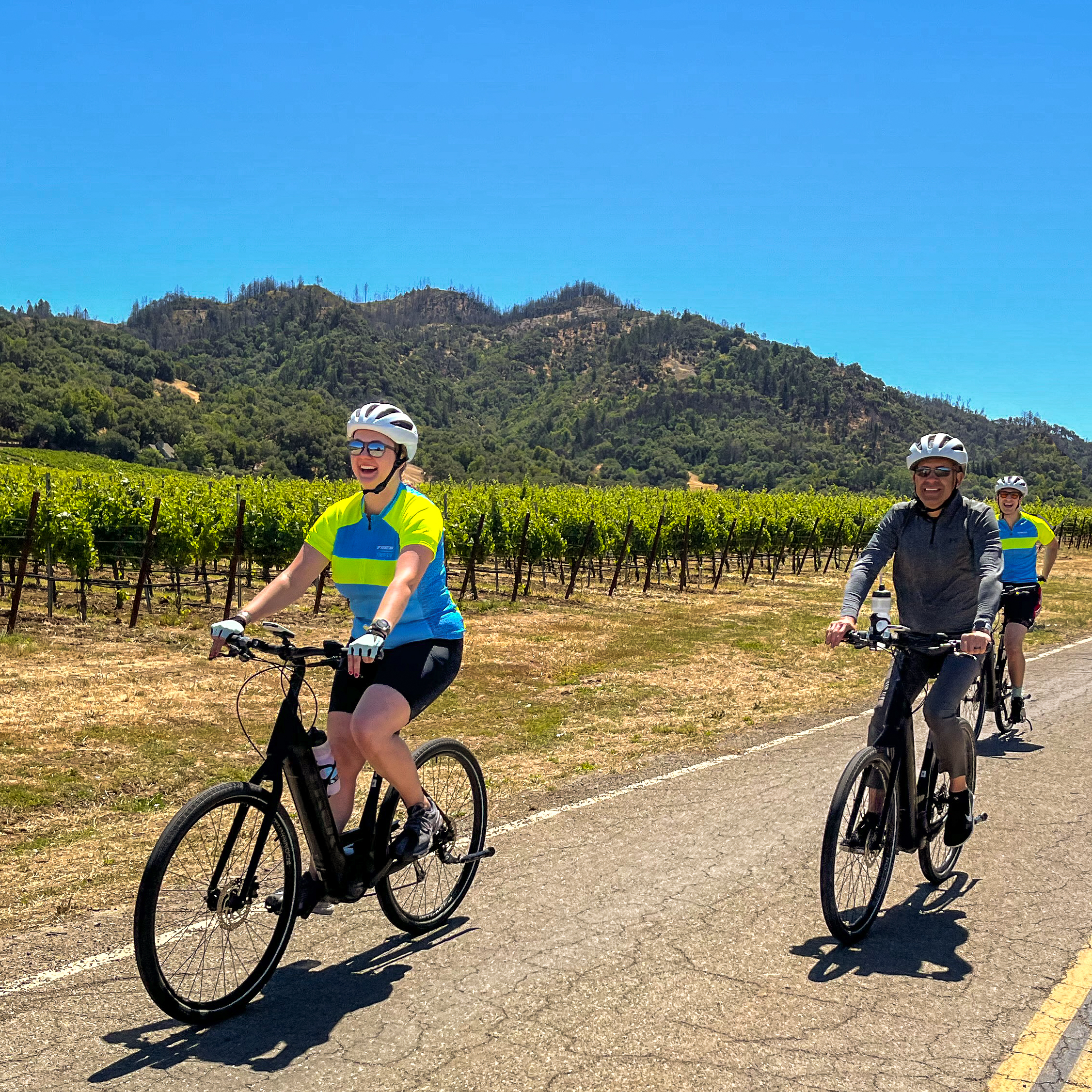
California Wine Country Bike Tour
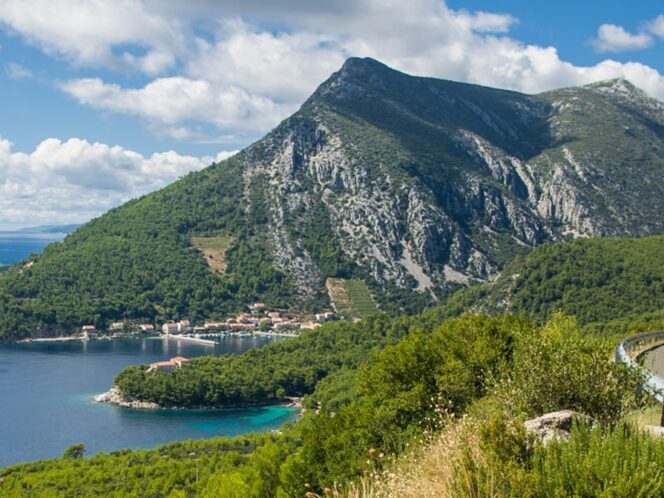
Croatia and The Dalmatian Coast Bike Tour
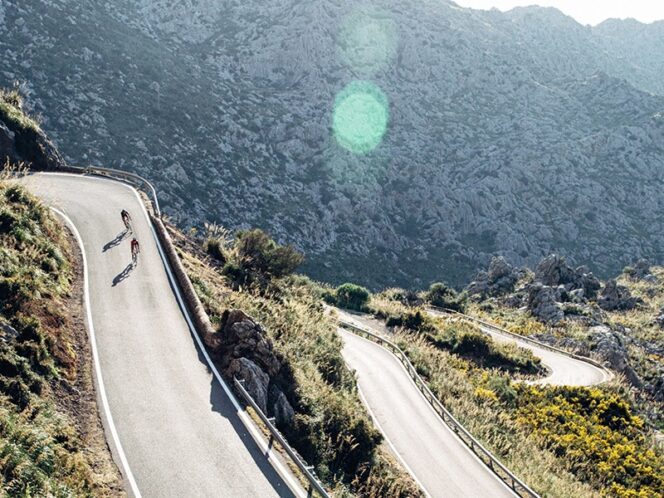
Mallorca 7-Day Ride Camp Bike Tour
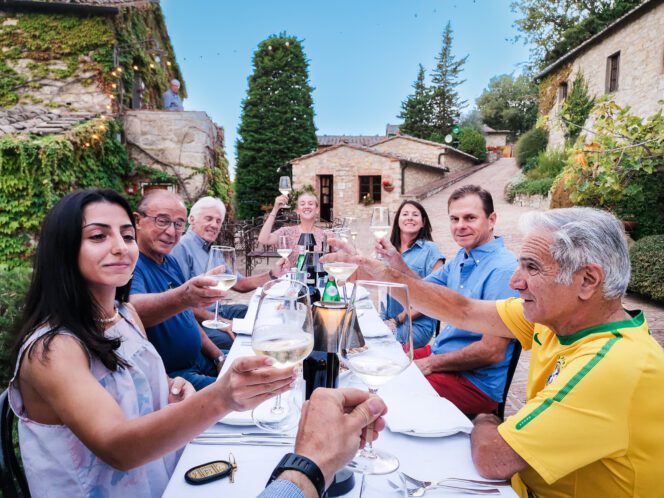
Tuscany Bike Tour
Trek Travel Guide Applications
Become a guide.
Interested in bike tour guide jobs? Click the articles below to read through all the details on what it takes to be a Trek Travel Guide! Apply as soon as possible to get the process started. Our applications are reviewed in the order they are received, and the 2024 season will be here before you know it!
Please note: Our Selection Process is fully virtual and our Training Event will be a combination of virtual learning and a week of in-person training in Madison, Wisconsin or Girona, Spain, depending on an applicant’s continent of residence. Guides will only work in their continent of residence.
Helpful Resources
So you want to be a guide? We can’t wait to hear from you! You can find all the answers to your questions about our bike tour guide jobs by reading the pdfs below. Contact [email protected] if you have questions.
Letter from Tania Burke
Life of a guide, job details, requirements to apply, application process, trek travel blog.
If a date is marked as Private, it is reserved for a private group.
Looking to travel with a small group or looking for a custom date? Call our trip consultants at 866-464-8735
What is the Difference?
Ultimate luxury:.
Savor some of the most spectacular, 5-star properties in the world. Exuding luxury and elegance, these one-of-a-kind accommodations offer the chance to rejuvenate at award-winning spas, dine at Michelin-starred restaurants, and more.
Enjoy luxurious accommodations handpicked for a refined experience. From signature spa treatments to delicious local cuisine, you’ll be more than provided for; you’ll be pampered.
These handpicked hotels provide relaxation and fun in a casual and comfortable environment. Delicious cuisine and great service mix perfectly for a memorable stay.
On select cycling vacations, you’ll stay at a mix of hotel levels, from Explorer to Luxury to Ultimate Luxury. Rest assured, no matter which level of hotel you’re at, our trip designers carefully select every accommodation.
Activity Level
Road : 1-3 hours of riding. Up to 25 mi (40 km). Up to 1,000 ft (300 m).
Gravel: 1-3 hours of riding. Up to 20 mi (35 km). Up to 1,000 ft (300 m).
Hiking: 1-3 hours of hiking. Up to 5 mi (8 km). Up to 1,000 ft (300 m).
Road : 2-4 hours of riding. 20-35 mi (35-60 km). Up to 2,500 ft (750 m).
Gravel: 2-4 hours of riding. 15-30 mi (25-45 km). Up to 2,000 ft (300 m).
Hiking: 2-4 hours of hiking. 4-8 mi (6-12 km). Up to 1,500 ft (450 m).
Road : 3-5 hours of riding. 25-55 mi (40-85 km). Up to 4,500 ft (1,500 m).
Gravel: 3-5 hours of riding. 20-40 mi (35-60 km). Up to 3,000 ft (900 m).
Hiking: 3-5 hours of hiking. 6-10 mi (9-16 km). Up to 2,000 ft (600 m).
Road : 4+ hours of riding. 40-70 mi (60-110 km). Up to 8,000 ft (2,400 m).
Gravel: 4+ hours of riding. 30-50 mi (45-80 km). Up to 4,000 ft (1,200 m).
Hiking: 4+ hours of hiking. 7-15 mi (11-24 km). Up to 4,000 ft (1,200 m).
What are your trip styles?
Classic - reserve:.
Savor the finer things as you relax in luxurious 5-star accommodations and wine, dine, and ride in some of the most unforgettable destinations around the world.
Classic - Signature:
Explore beautiful destinations by bike, enjoy extra inclusions, savor delicious local cuisine, and enjoy the perfect mix of accommodations.
Classic - Discovor:
Enjoy a casual cycling vacation with fantastic routes and comfortable accommodations.
Train like the pros in some of their favorite riding destinations.
See the pros in action at the biggest cycling events of the year.
Cross Country:
Tackle an epic adventure that takes you point-to-point across mountains, countryside, and more.
Self-Guided
Enjoy a bike tour on your schedule with just your chosen travel companions.
Single Occupancy
Sometimes it’s more convenient and comfortable to have your own room while on vacation. We understand and that’s why we offer a Single Occupancy option. The additional price guarantees a private room all to yourself
This website uses cookies to ensure you get the best experience on our website.

Burnham Has Now Lived Star Trek: Discovery’s Time Travel Both Ways
WARNING: Contains SPOILERS for Star Trek: Discovery Season 5, Episode 4, "Face the Strange."
- Captain Michael Burnham got to experience the USS Discovery's time travel to the 32nd century from another perspective.
- Burnham wore the Red Angel suit and led Discovery to the future at the end of Star Trek: Discovery season 2.
- Star Trek: Discovery season 5, episode 4 put Burnham on the bridge to see what was like to time travel aboard the USS Discovery.
Thanks to Star Trek: Discovery season 5, episode 4, "Face the Strange's" time travel, Captain Michael Burnham (Sonequa Martin-Green) has now experienced the USS Discovery's journey to the 32nd century from two perspectives. At the end of Star Trek: Discovery season 2, Burnham donned the Red Angel time suit and led the USS Discovery to the 32nd century . This prevented the genocidal A.I. called Control from gaining access to the massive amount of data that had been gathered by an ancient sphere and using it to eradicate all sentient life in the galaxy.
In Star Trek: Discovery season 5, episode 4 , "Face the Strange," written by Sean Cochran and directed by Lee Rose, Captain Burnham and Commander Rayner (Callum Keith Rennie), find themselves jumping through various time periods in Discovery's past, present, and future. One of these jumps places them on the Discovery as it follows Michael's Red Angel through the wormhole to the future. This was Rayner's first time experiencing the USS Discovery's one-way trip to the 32nd century, but it marked the second time and second perspective for Burnham , who got see herself as the Red Angel lead her starship to the distant future.
Star Trek: Discovery Season 5 Returning Cast & New Character Guide
Star trek: discovery season 5 gave burnham both time travel experiences to the 32nd century, burnham was the red angel and also saw things from discovery's bridge..
In Star Trek: Discovery season 2's two-part finale , Michael used the Red Angel suit to travel through time and set the red burst signals that Discovery had been tracking throughout the season. After this, she placed a sixth signal so that the ship could follow her 930 years into the future. Burnham experienced this time travel journey alone, while Commander Saru (Doug Jones) led the USS Discovery and its remaining crew members into the wormhole to the 32nd century. Michael arrived in the future one year before Discovery, and she began searching for the remnants of Starfleet and the United Federation of Planets.
Star Trek: Discovery season 5's “Face The Strange” revisits several moments of Discovery's past, including its journey to the 32nd century. This time, Michael stands on the bridge, watching herself as the Red Angel leading Discovery into the future. When Burnham and Rayner arrive at this particular moment in time, Discovery's crew members are unconscious due to tidal forces in the wormhole. Burnham and Rayner then have to work together, with help from Commander Paul Stamets (Anthony Rapp) , to determine the cause of the time jumps and stop the Krenim "time bug" responsible for them.
Since Stamets possesses tardigrade DNA, he exists outside of time and also remains aware of the time jumps.
What Happened After Burnham and Discovery Arrived In The Future
Burnham arrived through the wormhole about a year before discovery..
In Star Trek: Discovery season 3, episode 1, "That Hope Is You, Part 1," Commander Michael Burnham arrives in 3188, flying out of the wormhole and colliding with the ship of Cleveland Booker (David Ajala). Burnham and Book's ship both crash-land on the planet Hima. After sending the Red Angel suit to send the final signal and then self-destruct, Michael sets off to find the ship that crashed into her. Booker initially attacks Michael, but the two eventually form an uneasy alliance, as Michael tries to determine the whereabouts of the USS Discovery.
Burnham learned upon arriving in the 32nd century that the United Federation of Planets had collapsed because of The Burn.
Burnham and Booker become romantic and work together as couriers for a year before the USS Discovery finally emerges from the wormhole. When Discovery crash lands on an icy planet, the crew set about trying to repair the ship. Saru and Ensign Sylvia Tilly (Mary Wiseman) go to a nearby settlement to get the necessary materials to repair Discovery, but by the time they make it back, the ship has become encased in ice. Then Michael arrives and uses Book's ship to save Discovery, before tearfully reuniting with her friends. Star Trek: Discovery season 5 will bring the series to a close, and "Face the Strange" serves as a nice reflection on how far these characters have come.
New episodes of Star Trek: Discovery stream Thursdays on Paramount+.
Star Trek: Discovery
Cast Blu del Barrio, Oded Fehr, Anthony Rapp, Sonequa Martin-Green, Doug Jones, Wilson Cruz, Eve Harlow, Mary Wiseman, Callum Keith Rennie
Release Date September 24, 2017
Showrunner Alex Kurtzman
Where To Watch Paramount+

Screen Rant
Star trek: discovery’s biggest time travel shock is season 1 burnham.
Captain Michael Burnham faced her younger self in Star Trek: Discovery season 5, and it was shocking how much Michael has changed from season 1.
Warning: SPOILERS for Star Trek: Discovery Season 5, Episode 4 - "Face The Strange"
- Specialist Michael Burnham's shocking return in Star Trek: Discovery season 5 reveals a stark contrast to her future self, Captain Burnham.
- The time travel adventure in Discovery season 5, episode 4 sends Captain Burnham and crew on a dangerous mission to face their past and possible future.
- Captain Burnham's evolution into a compassionate leader highlights her remarkable transformation, making her the most evolved Captain in Star Trek history.
The biggest shock of Star Trek: Discovery season 5, episode 4's time travel was seeing Specialist Michael Burnham (Sonequa Martin-Green) from Star Trek: Discovery season 1 again, and how much Michael has changed. Written by Sean Cochran and directed by Lee Rose, Star Trek: Discovery season 5, episode 4, "Face the Strange," was a thrilling time travel adventure that sent Captain Michael Burnham (Sonequa Martin-Green), Commander Rayner (Callum Keith Rennie), and Commander Paul Stamets (Anthony Rapp) into key moments of the USS Discovery's past and possible future. And what Burnham dreaded came to pass: facing her younger self.
In Star Trek: Discovery season 5, episode 4, "Face the Strange," the villainous Moll (Eve Harlow) and L'ak (Elias Toufexis) smuggled a Krenim Chronophage, or a Time Bug, aboard the USS Discovery. The Time Bug trapped Discovery in a series of loops, sending the starship uncontrollably hurtling through time. However, Captain Burnham and Commander Rayner were able to operate independently in the time loops, and Stamets was also spared because his tardigrade DNA allows him to live outside of space-time. The Discovery trio went about destroying the Time Bug, but Burnham had to reveal herself to Discovery's bridge crew to save the ship. Further, Michael had to literally contend with herself from Star Trek: Discovery season 1.
Star Trek: Discovery Season 5 Returning Cast & New Character Guide
Why michael burnham was shockingly different in star trek: discovery season 1, discovery season 1 michael was defined by her biggest mistake..
Captain Burnham confronting Specialist Michael Burnham from Star Trek: Discovery season 1 was as shocking for her as it was for the viewers at home. The contrast between both Michaels, who were 5 years of age and 935 years apart after the USS Discovery time traveled to the 32nd century, was stunning. Captain Burnham is physically different from Specialist Burnham, not just because her hair is longer, and she wears a Starfleet Captain's uniform. There is a warmth and compassion to Captain Burnham that is absent from her younger self , who was just weeks removed from the biggest mistake of her life.
Specialist Michael Burnham thought Captain Burnham was a changeling imposter, as she couldn't fathom herself as a Starfleet Captain.
At the point in Star Trek: Discovery season 1 that Captain Burnham arrived at, Specialist Michael Burnham was still mired in guilt and sorrow for her mutiny that ignited the Klingon War and led to the death of her mentor, Captain Philippa Georgiou (Michelle Yeoh). Michael was resigned to spend the rest of her life in prison, and Discovery season 1's Burnham does not believe she deserves to be in Starfleet. The younger Michael's appearance is harsher than Captain Burnham's , and she is more prone to judgment and not looking before leaping into action. Captain Burnham beat Specialist Burnham in hand-to-hand combat because she was more centered and in control of herself, but also filled with empathy for the younger Michael.
Michael Burnham Is Star Trek's Best Captain Evolution
No captain has changed for the better as much as burnham..
Star Trek: Discovery season 5, episode 4 is a powerful reminder that Michael Burnham is the most evolved Captain ever in Star Trek . By comparison to some of her peers, Captain James T. Kirk (William Shatner) did not change very much as he aged, except for facing his own regrets. Admiral Kathryn Janeway (Kate Mulgrew) in Star Trek: Prodigy is essentially the same as when she was the USS Voyager's Captain, just with a higher rank. Admiral Jean-Luc Picard (Patrick Stewart) isn't as stern as he was when he was Captain of the USS Enterprise-D, but Jean-Luc never had to overcome the obstacles to the Captain's chair that Michael Burnham did.
It was incredibly touching for Michael to see how much she changed for the better.
Seeing Star Trek: Discovery season 1's Specialist Michael Burnham again is a stark reminder of how far Burnham has come. By Star Trek: Discovery season 5, Captain Burnham is confidently at peace with herself, has reconciled her gravest mistakes, and has proven her worth by saving the galaxy multiple times. Burnham has also known true love with Cleveland Booker (David Ajala), and she has the friendship and support of her found family, the crew of the USS Discovery. Specialist Michael Burnham is only at the start of her long, hard road to redemption , and becoming Captain Michael Burnham is her destiny in Star Trek: Discovery. It was incredibly touching for Michael to see how much she has changed for the better.
New episodes of Star Trek: Discovery season 5 stream Thursdays on Paramount+

IMAGES
COMMENTS
Thank you, Trek Travel! Linda S. This trip exceeded my expectations. My first ever European cycling journey has left me grinning from ear to ear. Truly a spectacular experience. Dori L. This was my first Trek Travel trip and it is hard to imagine how it could have been any better. Without question the tour guides made the trip as perfect as it ...
Starting from her days as a guide in the adventure travel industry, Tania Burke has long been passionate about active travel. For over 20 years, she has been building Trek Travel from the ground up, driven by the desire to show people the world through active travel. Giving Back.
Our self-guided bike tours combine the freedom to explore your favorite destinations your way with the best parts of any Trek Travel itinerary—curated routes and itinerary suggestions at your fingertips, world-class Trek bikes, and the best accommodations along the way. You just have to wake up and go. View Self-Guided Bike Tours Travel Info.
Our Team Exceeding your expectations is in our DNA At Trek Travel, we believe there's no such thing as a crazy request. Maybe you're celebrating a special birthday. Maybe you want to find an out-of-the-way restaurant. Or maybe you've decided to propose marriage on the spot. Our guides and trip designers are trained to deliver 'wow' moments that are guaranteed to surprise and delight ...
Our guides are rated top in the world, certified mechanics, and experts in hospitality. With enhanced safety standards and all new ways to travel, including self-guided and private trips, explore ...
Gravel Bike Tours Adventure Unpaved Gravel bike tours by Trek Travel combine a mix of paved and gravel roads to let you explore some of our favorite regions in a whole new way. You'll pedal in classic Trek Travel style, with gravel-specific Trek Checkpoint SLR 7 bikes that are built to conquer any surface with ease. And along the way you may just discover a new side of cycling, the world ...
The support of the Trek Travel guides made it exceptionally easy and enjoyable. A perfect way to spend our 15-year wedding anniversary! Arch-Reply. November 1, 2016 at 4:19 pm. Trek is the best travel group especially for the Tour de France where access and logistics are so critical to a wonderful experience.
Trek Travel creates perfect vacations for travelers who want to see the world like they've never seen it before. ... Our guides are here for whatever you need whenever you need it, whether it's a shuttle up the hill or a wine recommendation. THE WORLD CALLS. Welcome to Trek Travel. Here, we don't just promise a cycling vacation.
Trek Travel trips feature full support from a chase van, GPS devices, on-bike guides, and a fleet of highly spec'd Trek Checkpoints, so riders don't have to worry about the hassle of traveling ...
An estimated 165,000 white blazes guide hikers along the 2,189 miles of trail. A "white blaze" is a 2 x 6 inch swatch of white paint typically placed on trees, rocks, sign posts, and various other locations signifying the path of the A.T. White blazes are also marked for both northbound and southbound travel.
10. Invest in a good pair of shoes. Photo by Kieran Wallace. Your feet are your most crucial body part on a trek, and it doesn't take much to keep them in toe-tappingly tip-top shape. First, invest in a pair of good-quality, water-resistant hiking boots; you want plenty of support and ventilation too. Then, wear them in.
Our guidebooks & travel books. Whether you're interested in traveling to a new city, going on a cruise, or cooking a new dish — we're committed to inspiring you to experience travel in a whole new way. Lonely Planet's collection of 825+ travel and guidebooks is sure to inspire the traveler within. View All Books.
With trips through beautiful destinations like Prague, Mallorca and California, this outfitter does it right with top-of-the-line bikes, exclusive activities and great hotels. No matter which adventure you choose, you'll be riding one of the best bikes in the world (like the Trek Madone 5.2 and Trek 7.7 FX). Aside from the technical specs ...
Step into Adventure. Our Hiking and Walking Tours are packed with everything that makes us great—the best guides, luxury accommodations, expertly designed itineraries, unmatched flexibility, and support from the moment you book to well after you depart—all delivered with what truly sets us apart: our unparalleled hospitality. Join us on our ...
Get the 360 view of Trek Travel. 50 traveler ratings + professional review. See photos, videos, itineraries and more to know if Trek Travel is right for you. ... The Trek Travel guides have extensive experience and knowledge, both in bike maintenance and leading tours. Trek Travel provides the perfect combination of luxury and activity, as you ...
Hidden Universe Travel Guide: Star Trek: Vulcan draws on 50 years of Star Trek TV shows, films, and novels to present a comprehensive guide to Spock's iconic home world. Modeled after real-world travel guides, the book will explore every significant region on Vulcan with fascinating historical, geographical, and cultural insights that bring the planet to life like never before.
Certified Guides. Every Trek Travel guide, whether cycling or hiking, is trained by top experts to ensure unparalleled expertise on the road or trail. Our cycling guides are mechanical wizards, skilled in everything from Di2 adjustments to chain repairs. Hiking guides will confidently navigate you through every trail with their safety-first ...
The only full day of our trip, Saturday's ride was the longest and most challenging. Options included a 14-mile trek with over 1,500 feet of climbing or an avid 28-mile route with over 3,000 ...
Paperback. $16.39 33 Used from $2.98 10 New from $10.99. Set in the Star Trek universe, this Hidden Universe travel guide explores all that Vulcan—Spock's home planet—has to offer in an interactive guidebook. Plan your next trip to the planet Vulcan! Find restaurants that serve the best fried sandworms and Vulcan port.
Hidden Universe: Star Trek: A Travel Guide to Vulcan draws on 50 years of Star Trek TV shows, films, and novels to present a comprehensive guide to Spock's iconic home world. Modeled after real-world travel guides, the book will explore every significant region on Vulcan with fascinating historical, geographical, and cultural insights that ...
Checkpoint. Checkpoint is the ultimate drop bar gravel bike for big adventures, gravel racing, and bikepacking. -Up to 45mm (2.1in) tire clearance. -Progressive geometry that balances quick handling with comfort. -Flared gravel handlebar for comfort on the long haul. -Tons of mounts for bags and racks. Shop Checkpoint Learn more.
Cordillera Huayhuash Trek Facts. The distance of this trek is 68 miles / 110km and takes 7-14 days to complete. Most people hike in a clockwise route. The maximum altitude on the circuit is 16,600 feet/ 5,060m. There is a total of 18,700 feet/ 5,700m of vertical uphill walking. Difficulty is strenuous.
Thank you for your interest in Trek Travel Bike Tour Guide position! We are currently recruiting for the 2025 season. We know how to find the perfect locations, boutique accommodations, idyllic towns, delectable meals, and extraordinary experiences. Our tour travel guides take the role of making this magic come to life, delivering every piece ...
Click the articles below to read through all the details on what it takes to be a Trek Travel Guide! Apply as soon as possible to get the process started. Our applications are reviewed in the order they are received, and the 2024 season will be here before you know it! Please note: Our Selection Process is fully virtual and our Training Event ...
Thanks to Star Trek: Discovery season 5, episode 4, "Face the Strange's" time travel, Captain Michael Burnham (Sonequa Martin-Green) has now experienced the USS Discovery's journey to the 32nd ...
Salkantay Trek is one of the best multi-day hikes in Peru that will take you from Cusco to Aguas Calientes, a gateway to Machu Picchu. Our Salkantay Trek travel guide includes everything you need to know; practical information, itinerary, useful tips, facts, trail length, difficulty, altitude, and also our experience with Alpaca Expeditions.
The biggest shock of Star Trek: Discovery season 5, episode 4's time travel was seeing Specialist Michael Burnham (Sonequa Martin-Green) from Star Trek: Discovery season 1 again, and how much Michael has changed. Written by Sean Cochran and directed by Lee Rose, Star Trek: Discovery season 5, episode 4, "Face the Strange," was a thrilling time travel adventure that sent Captain Michael Burnham ...